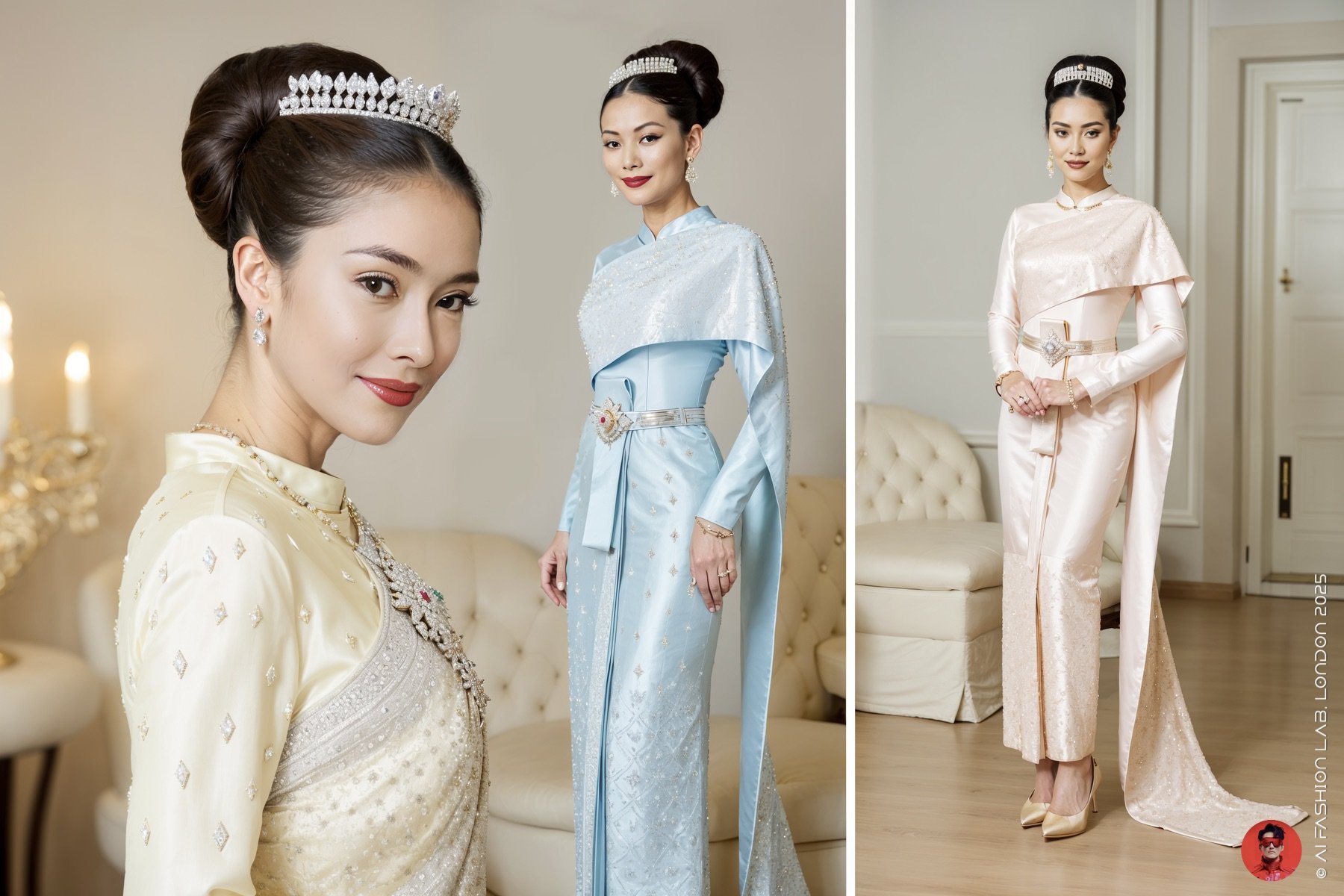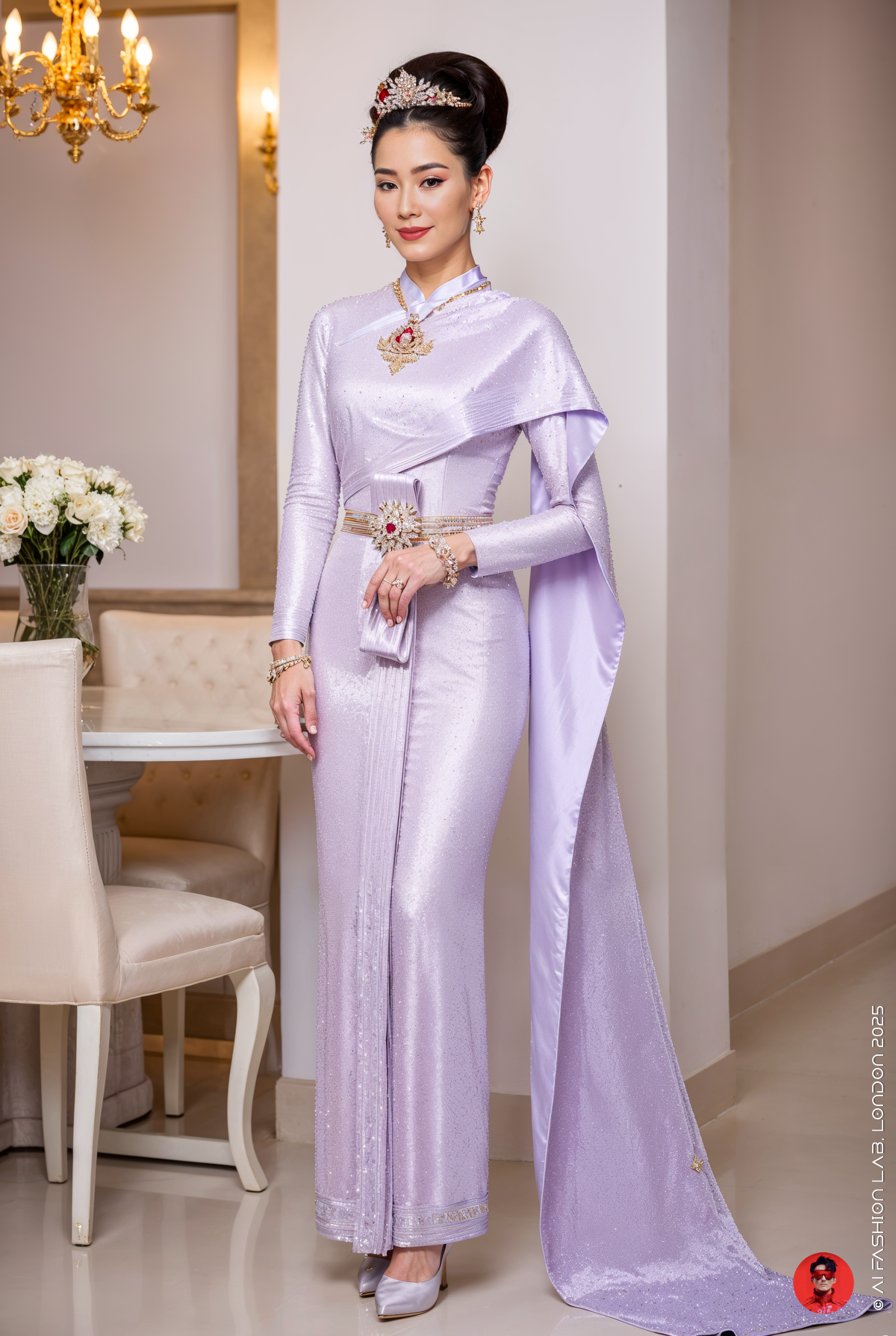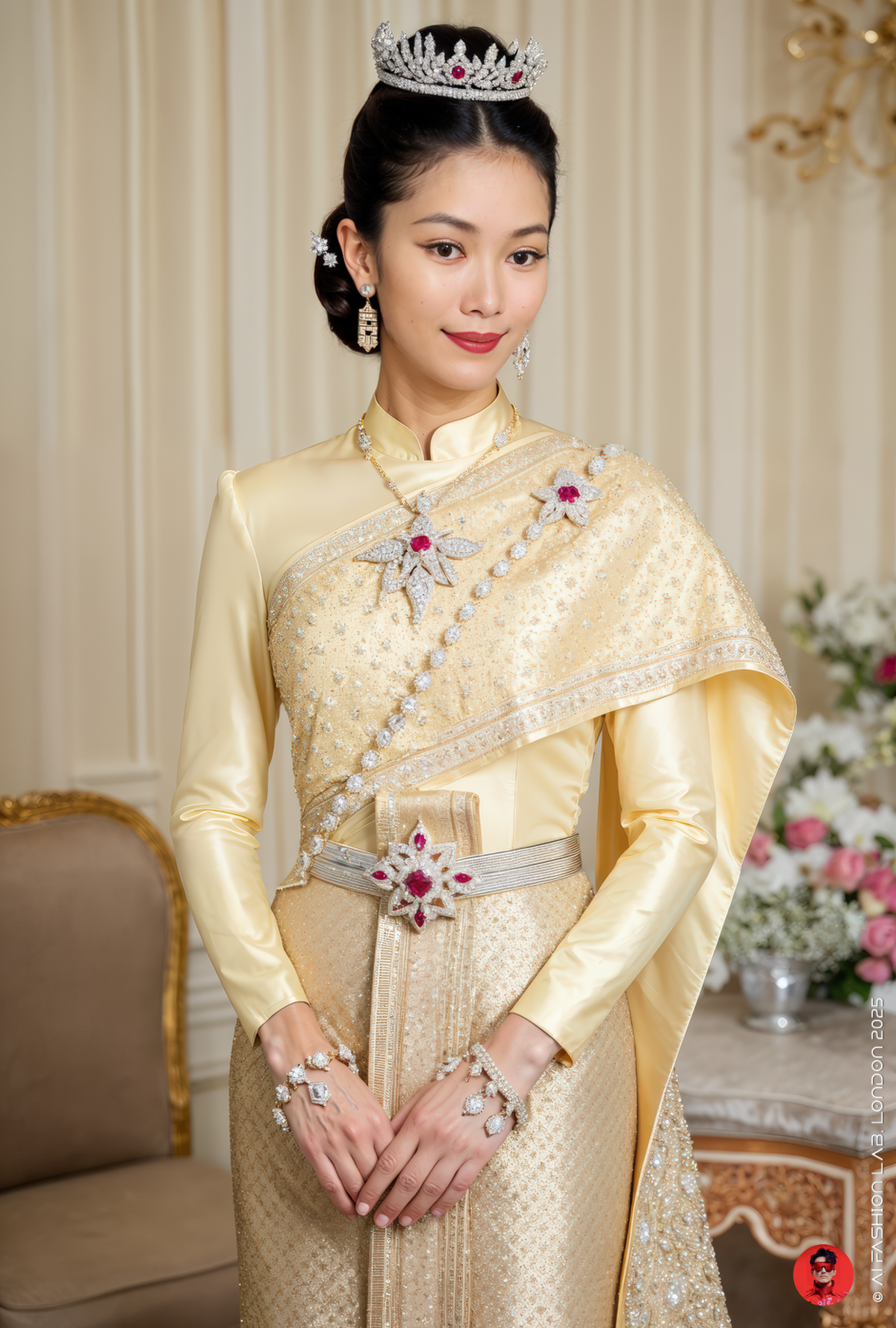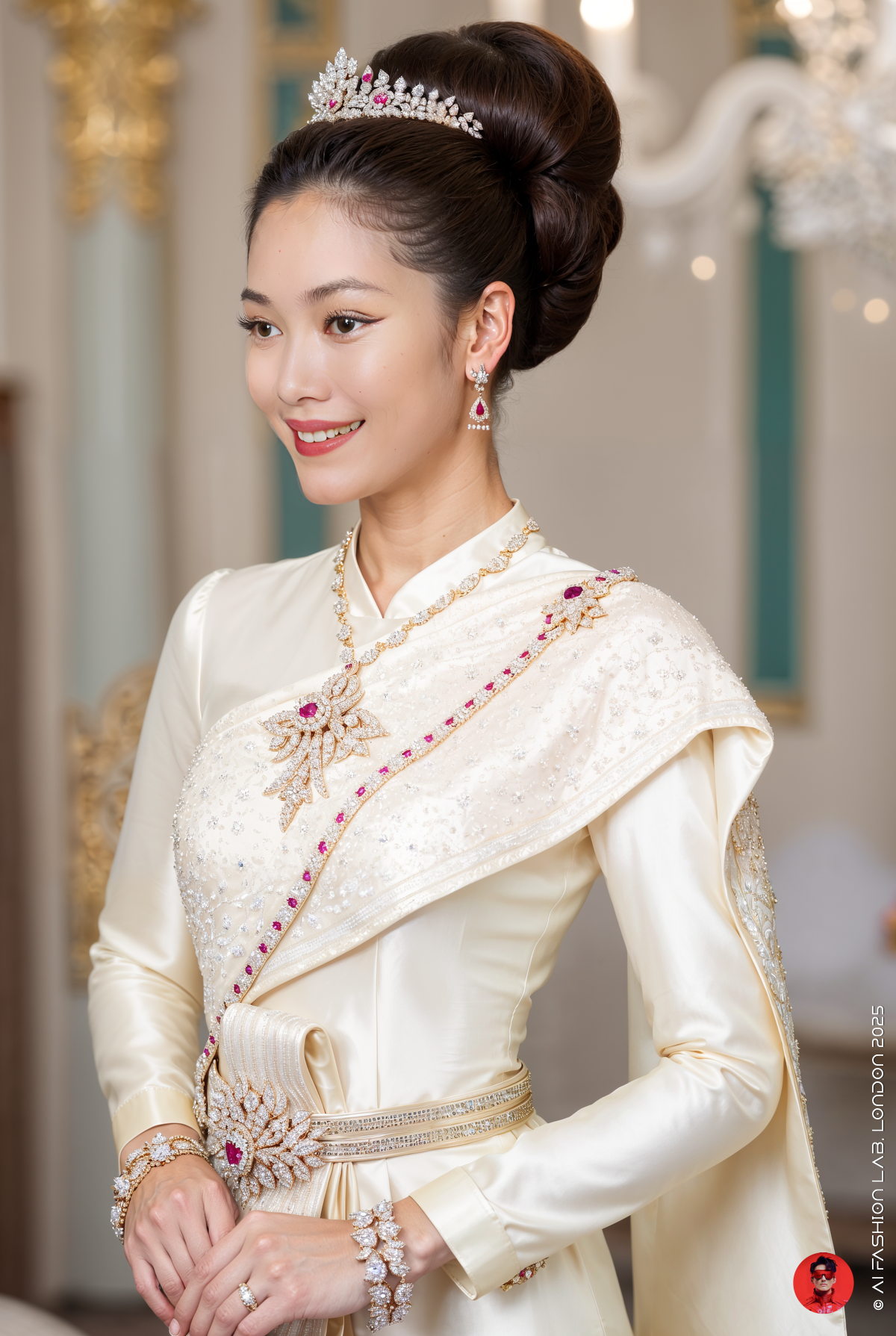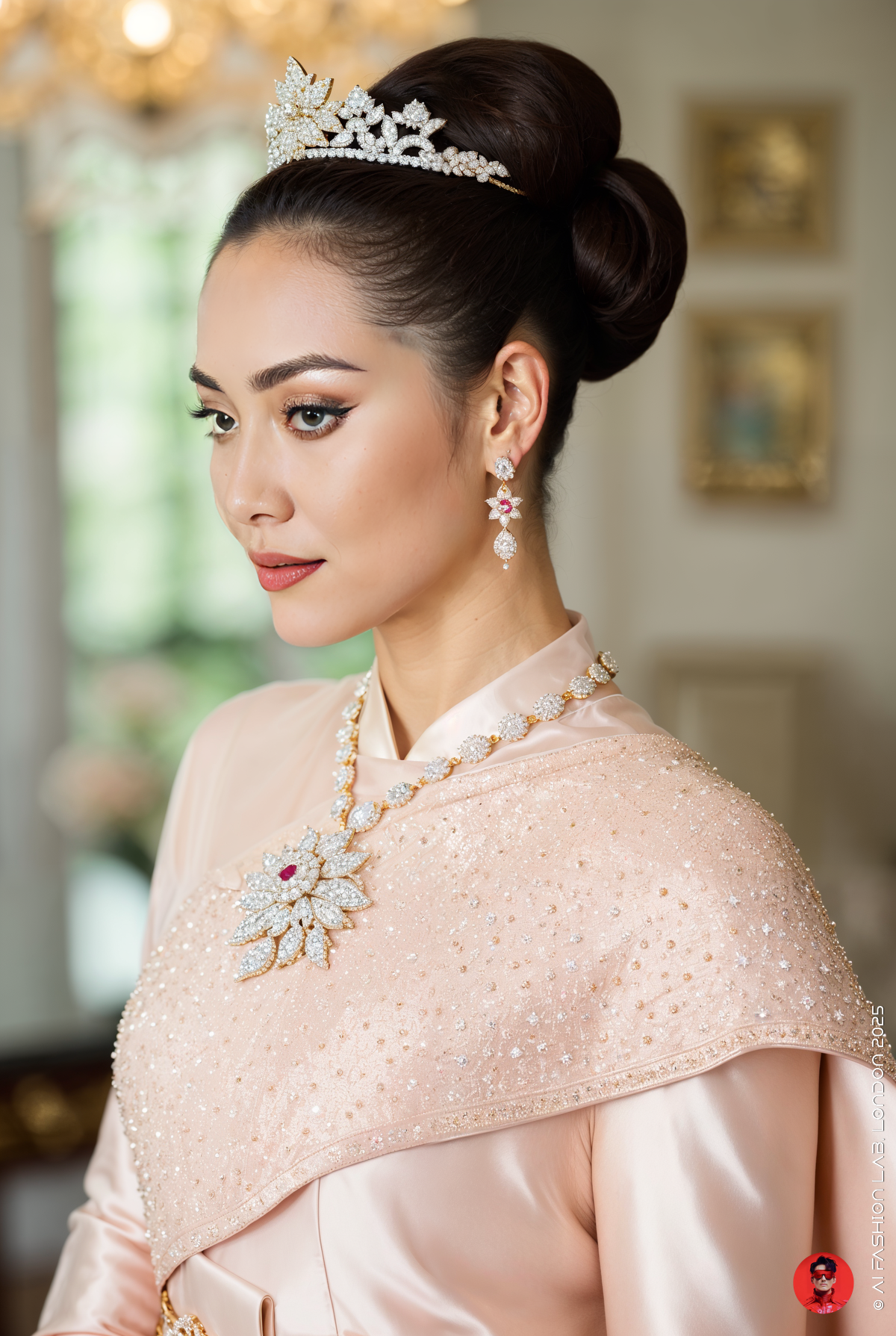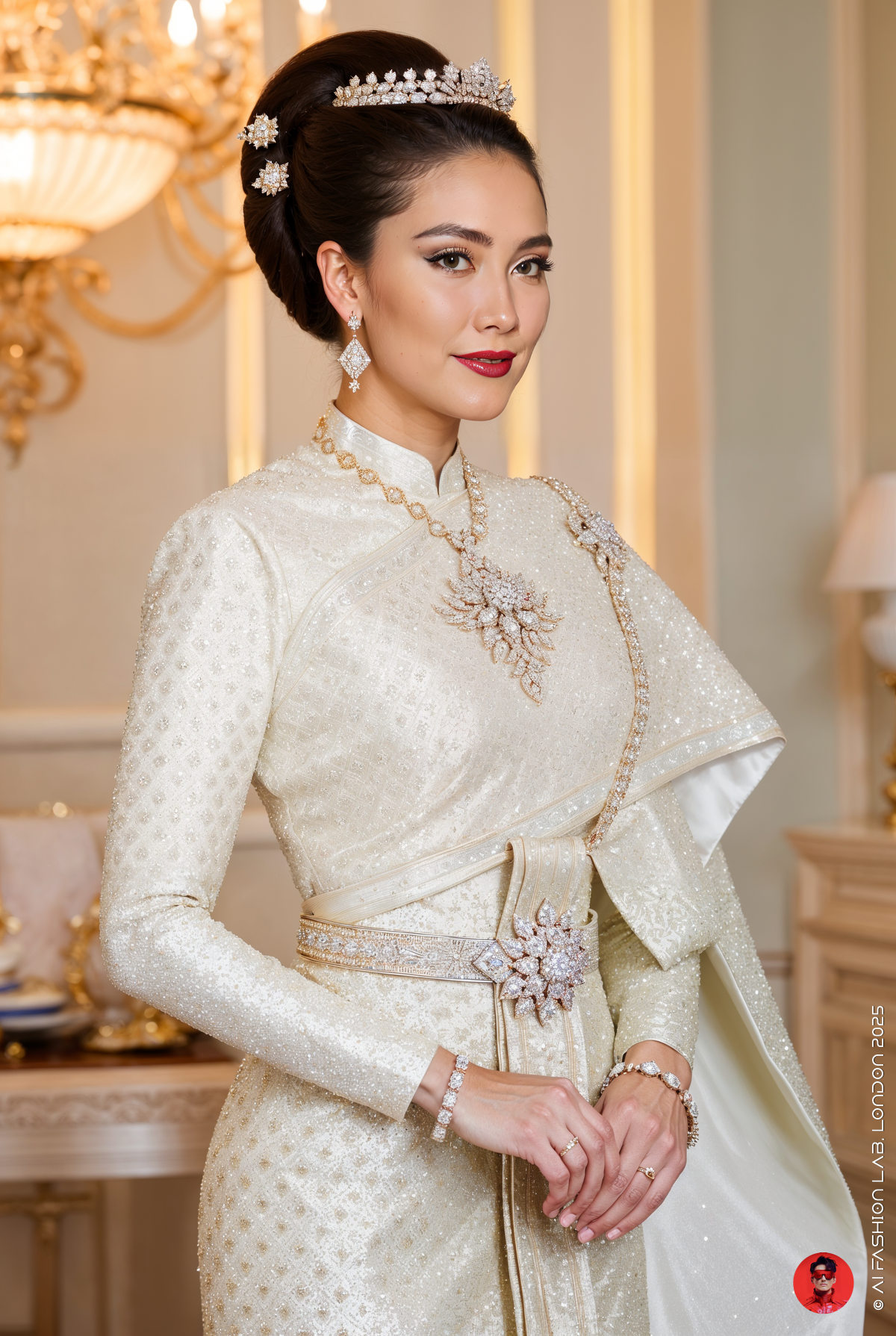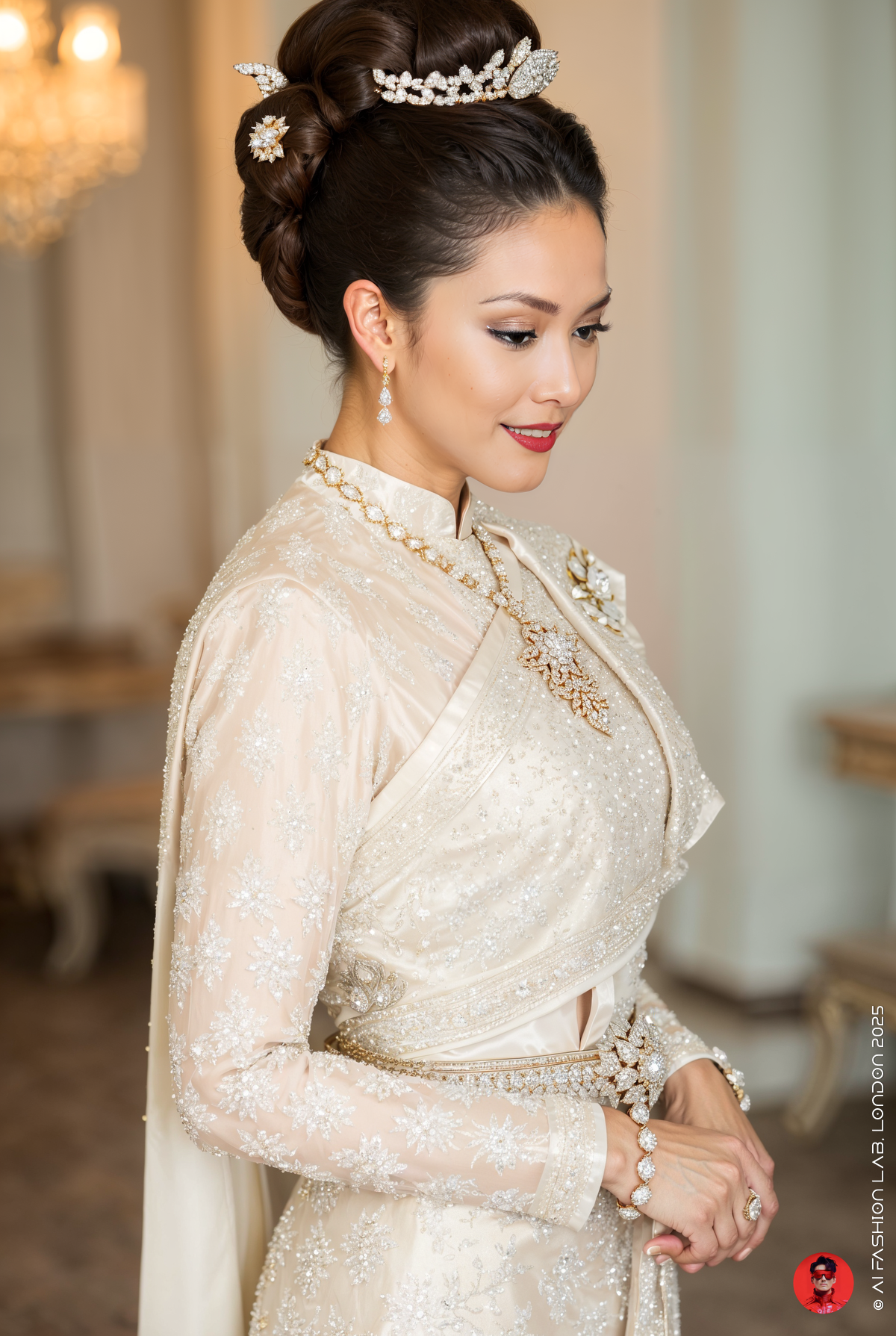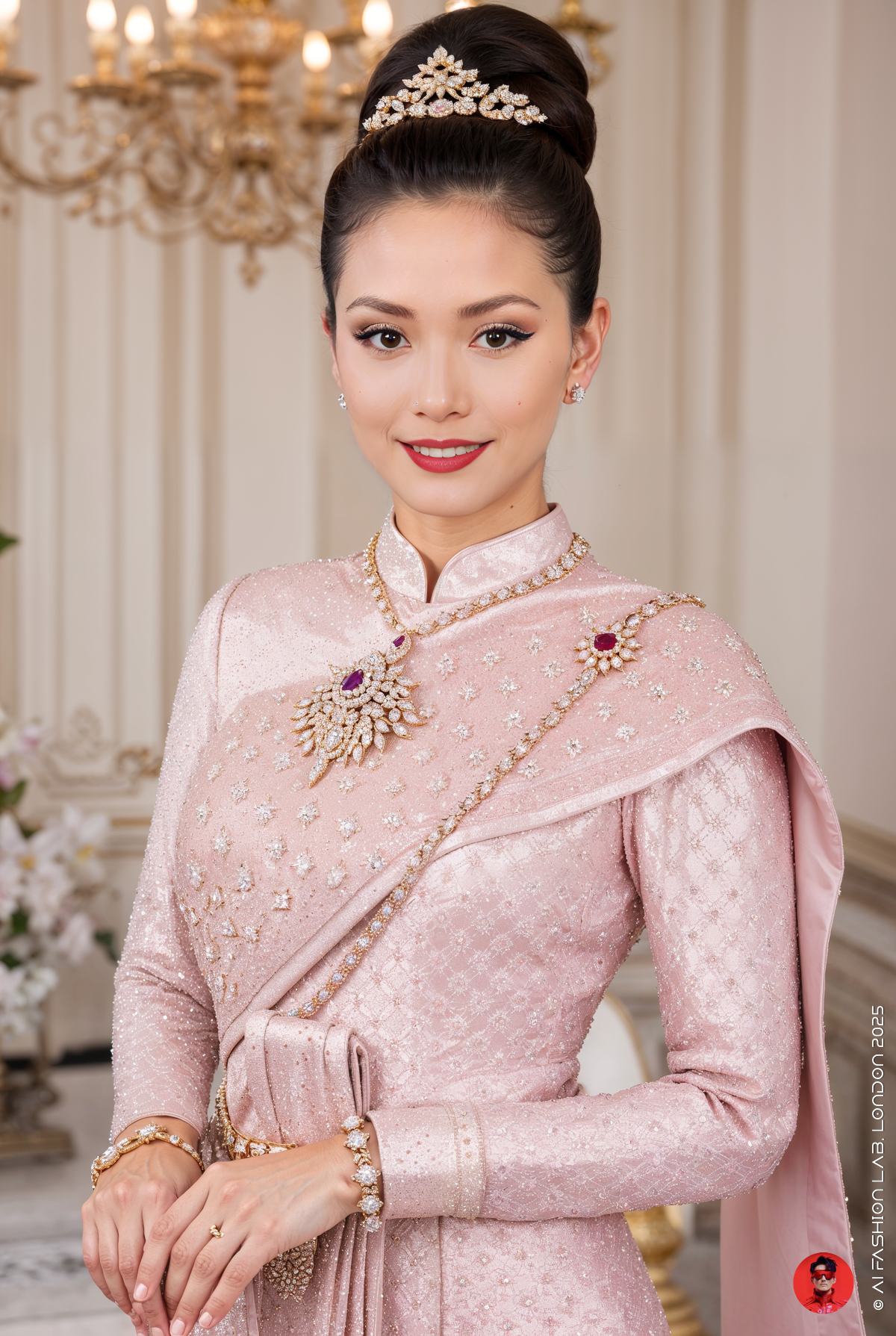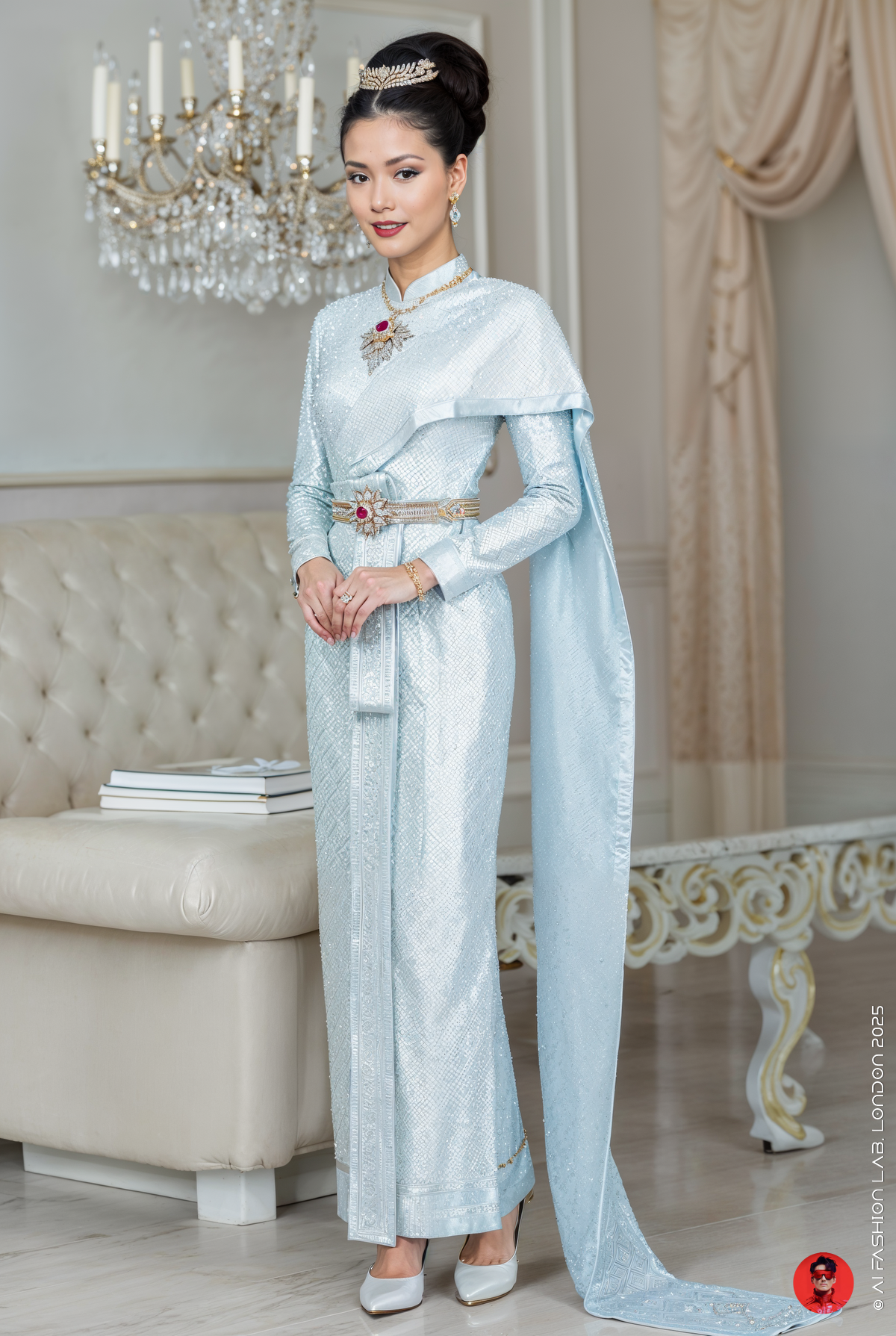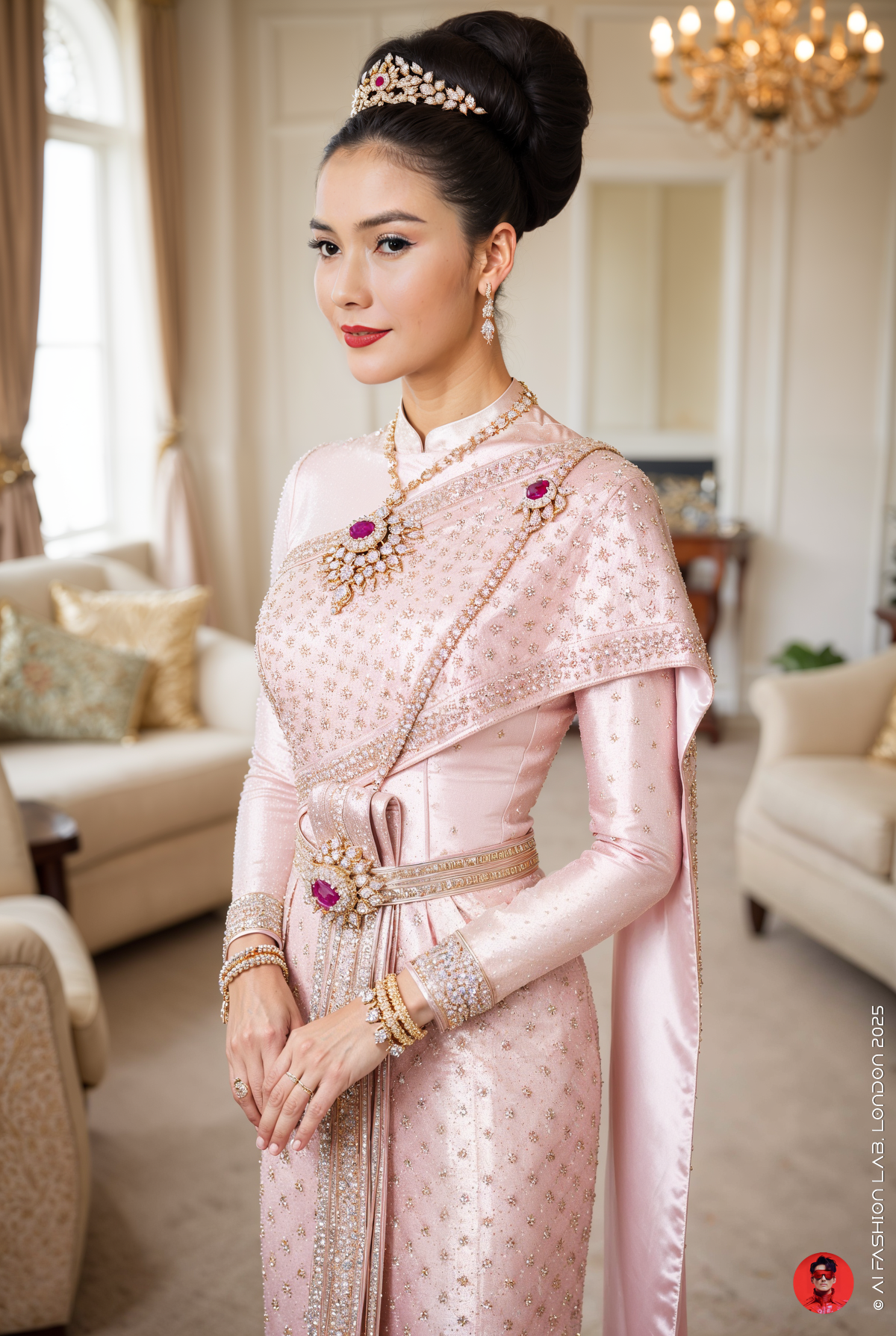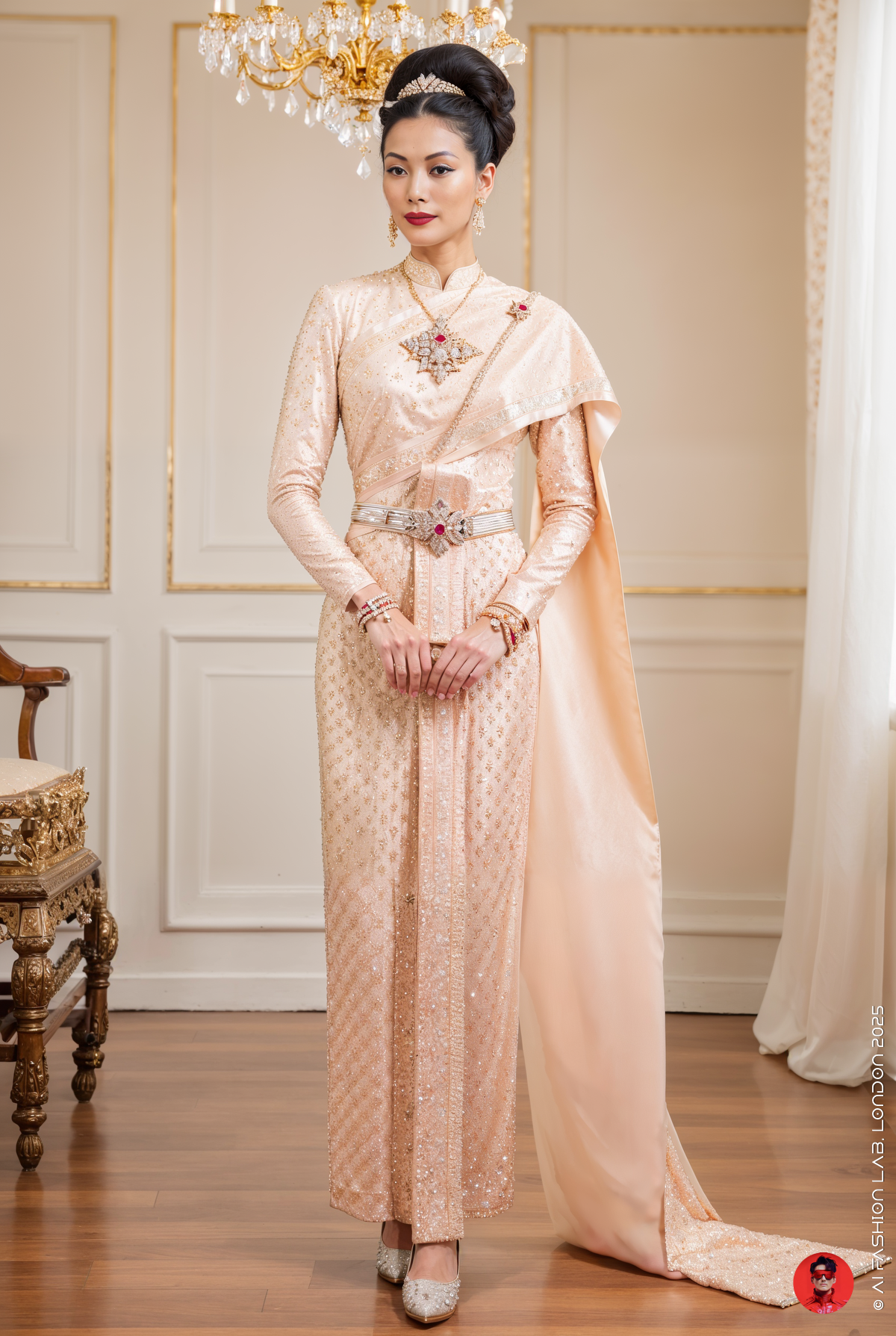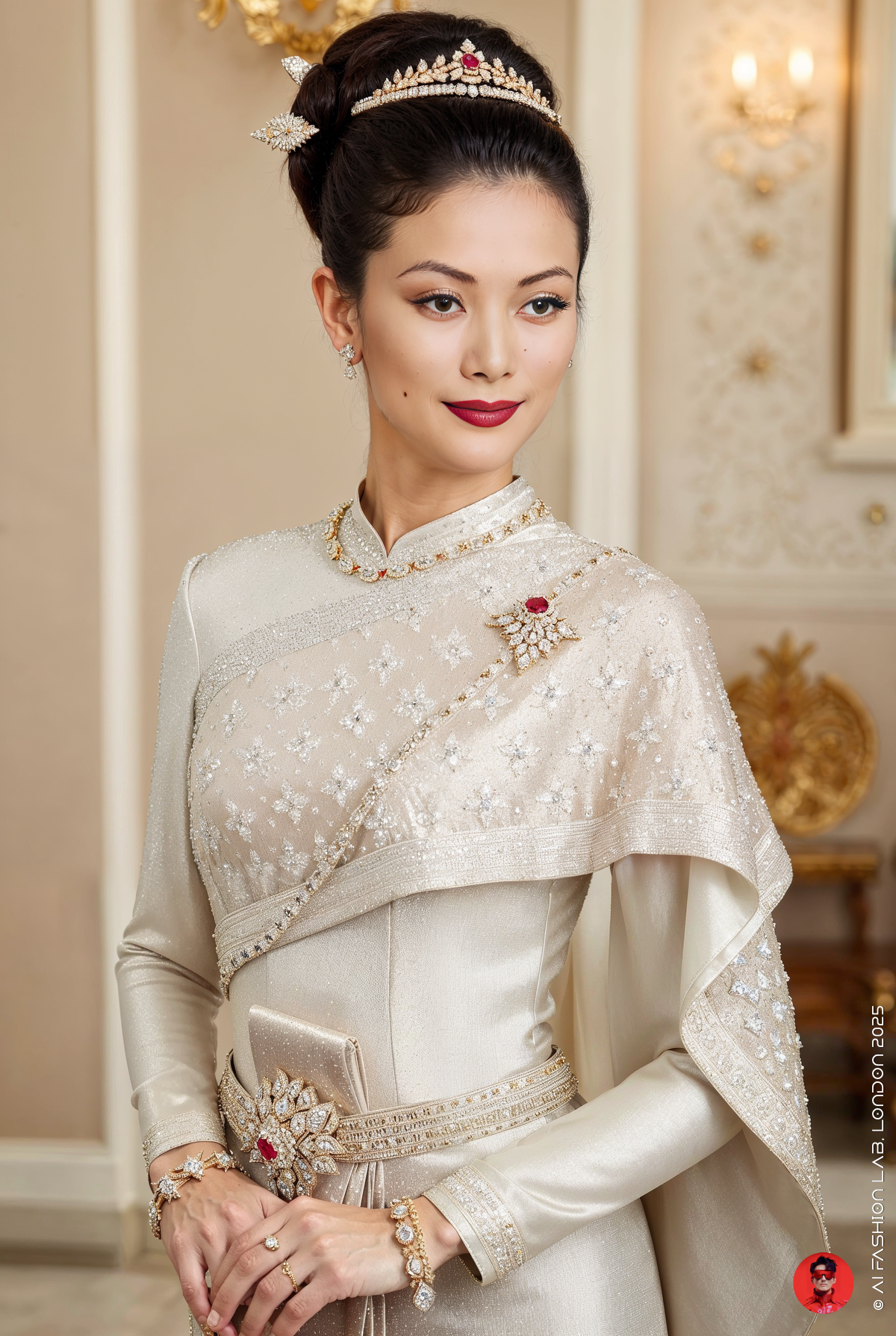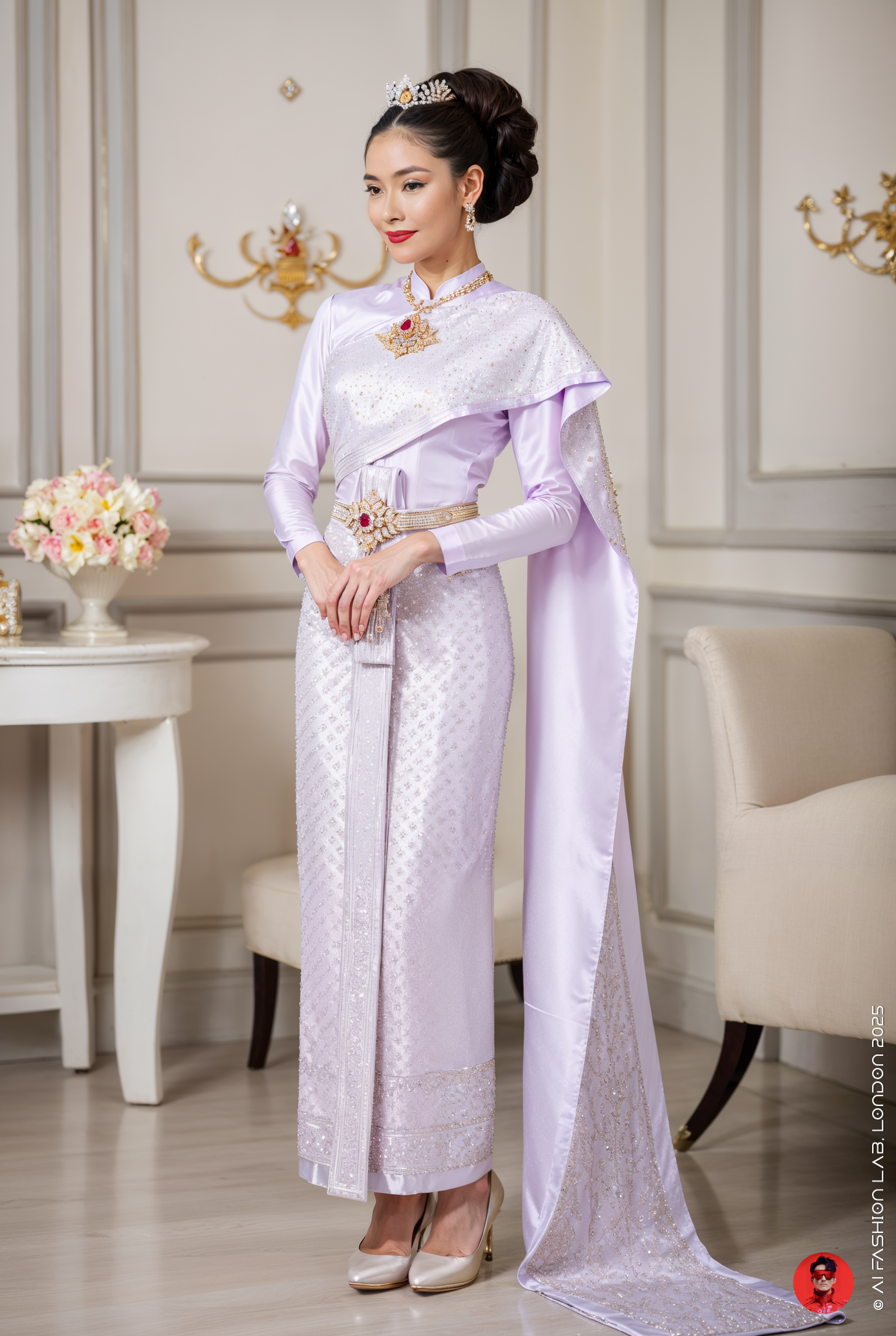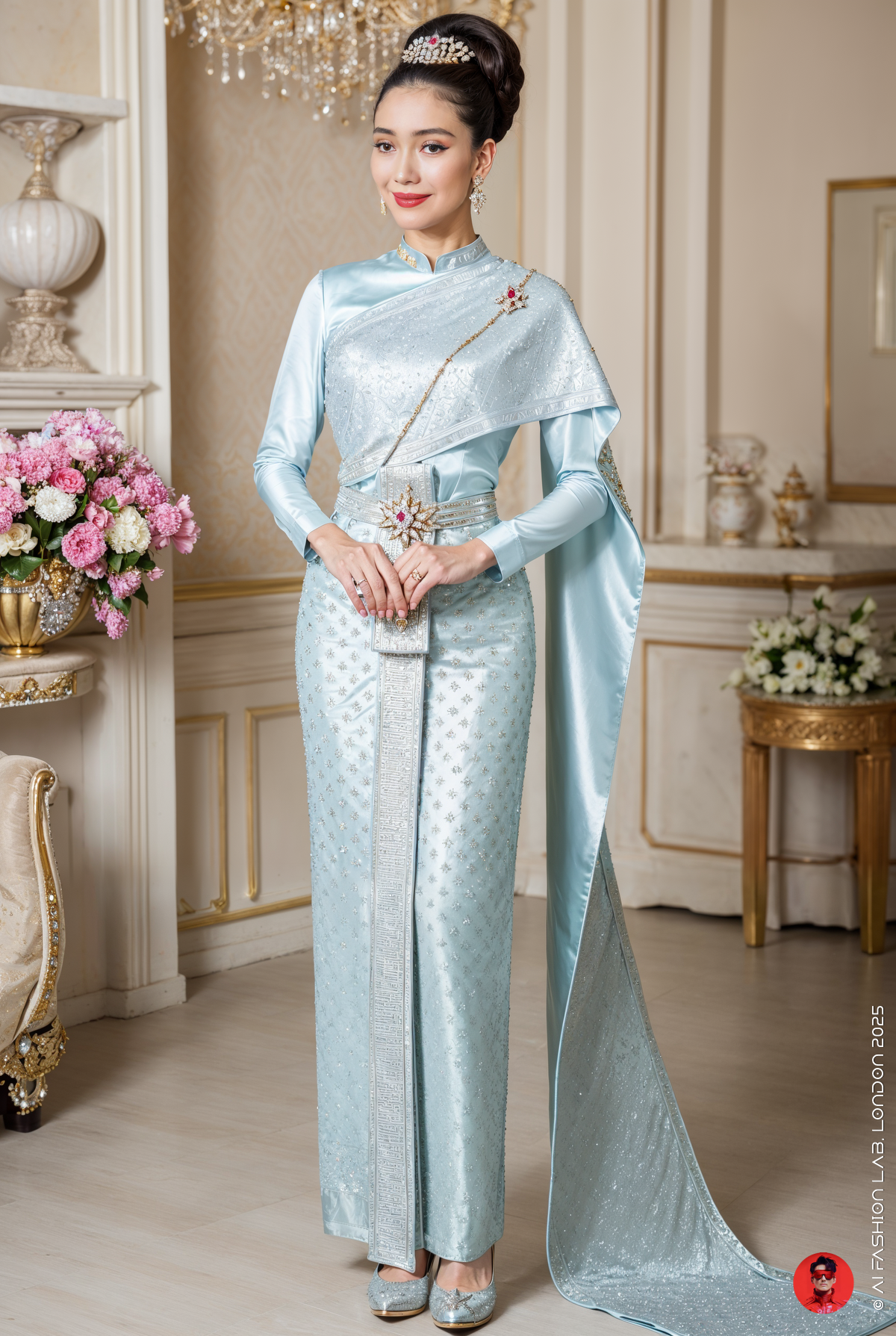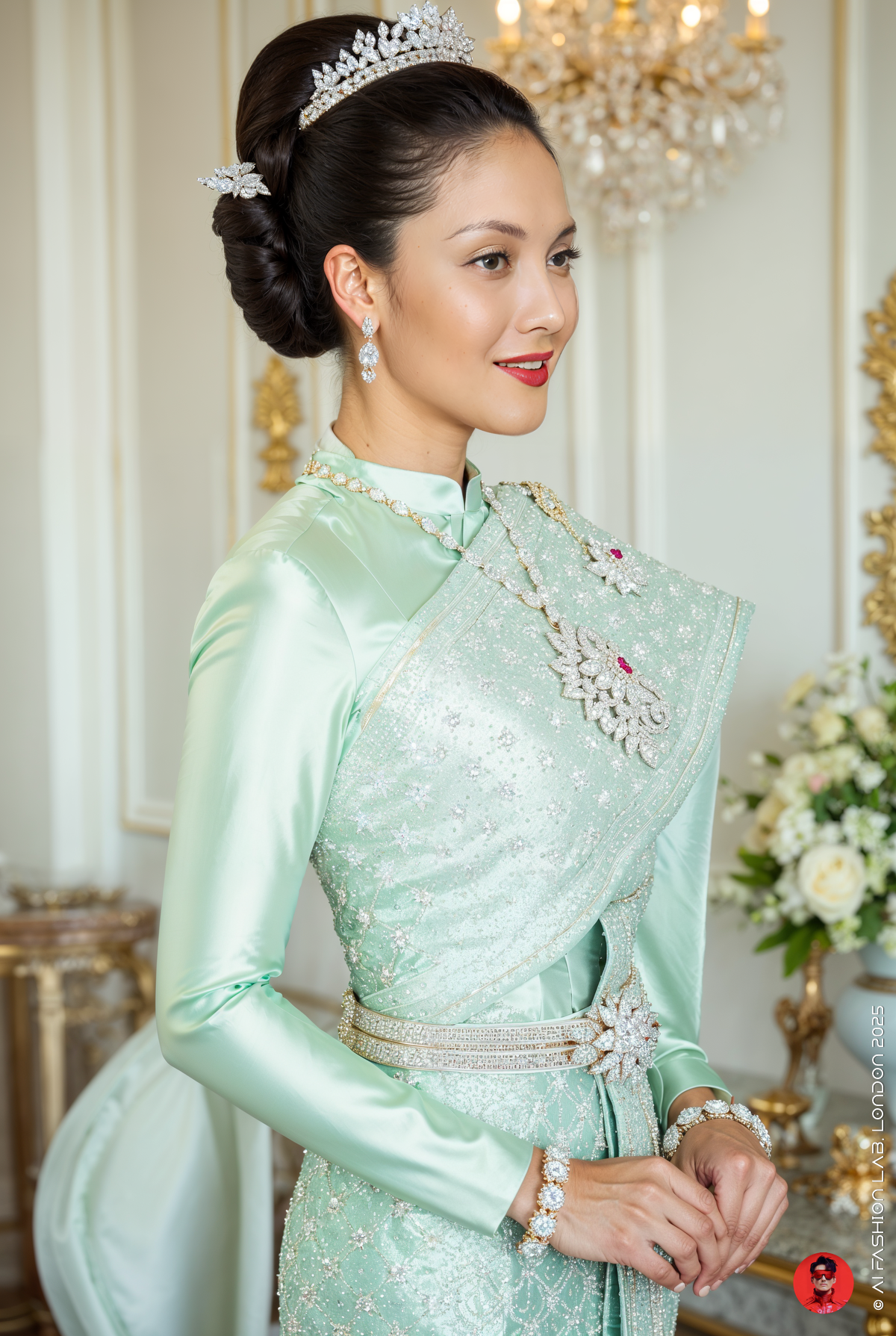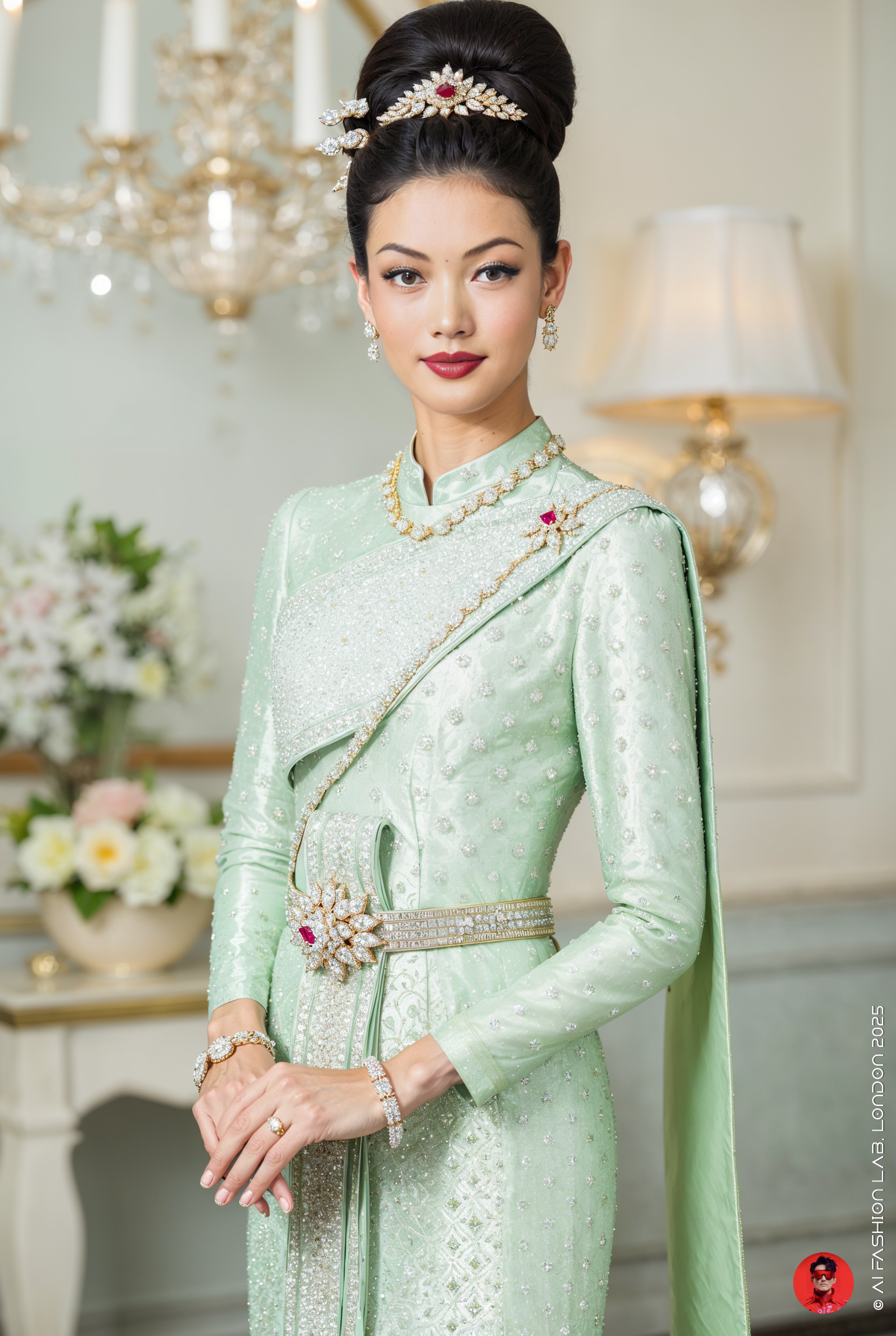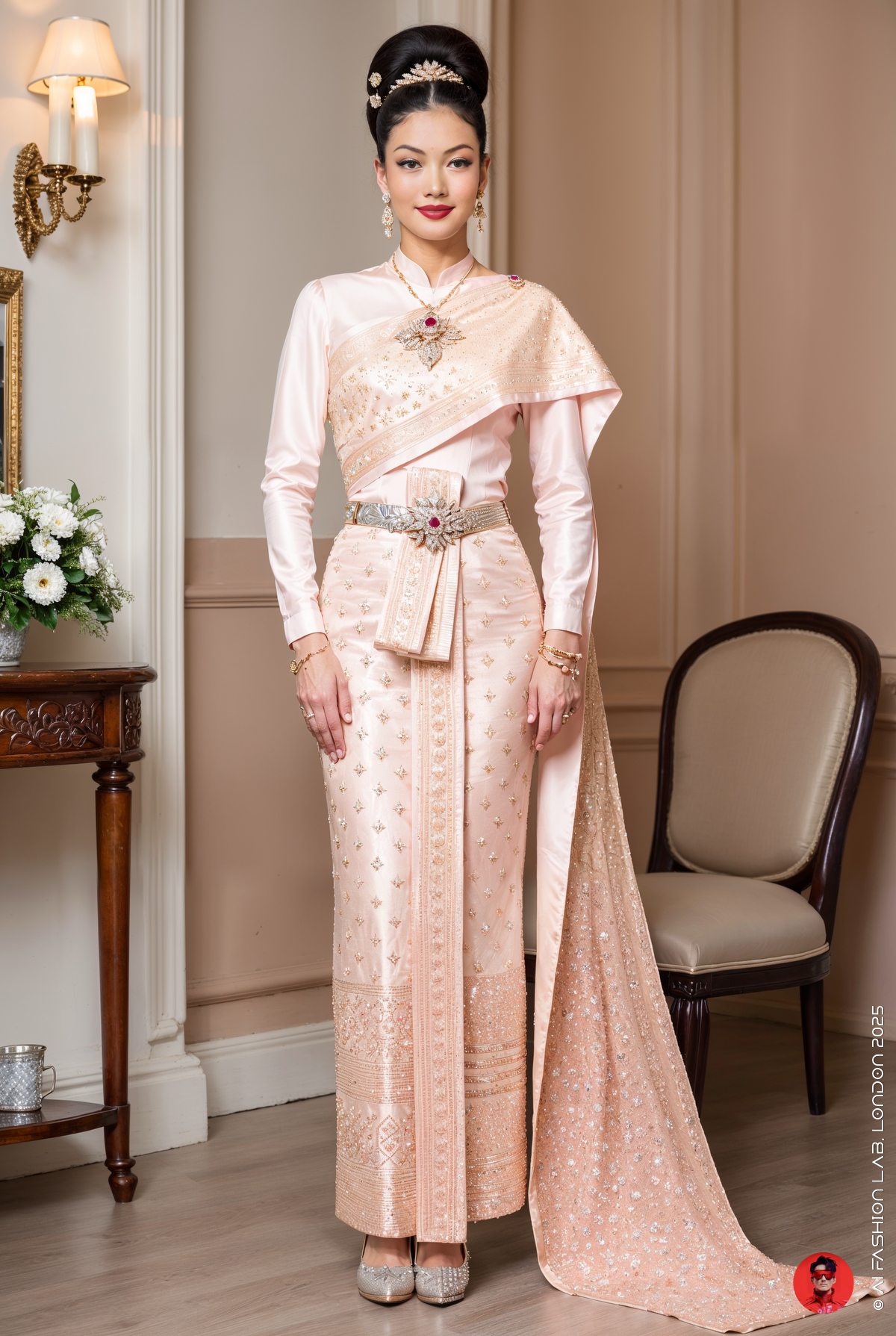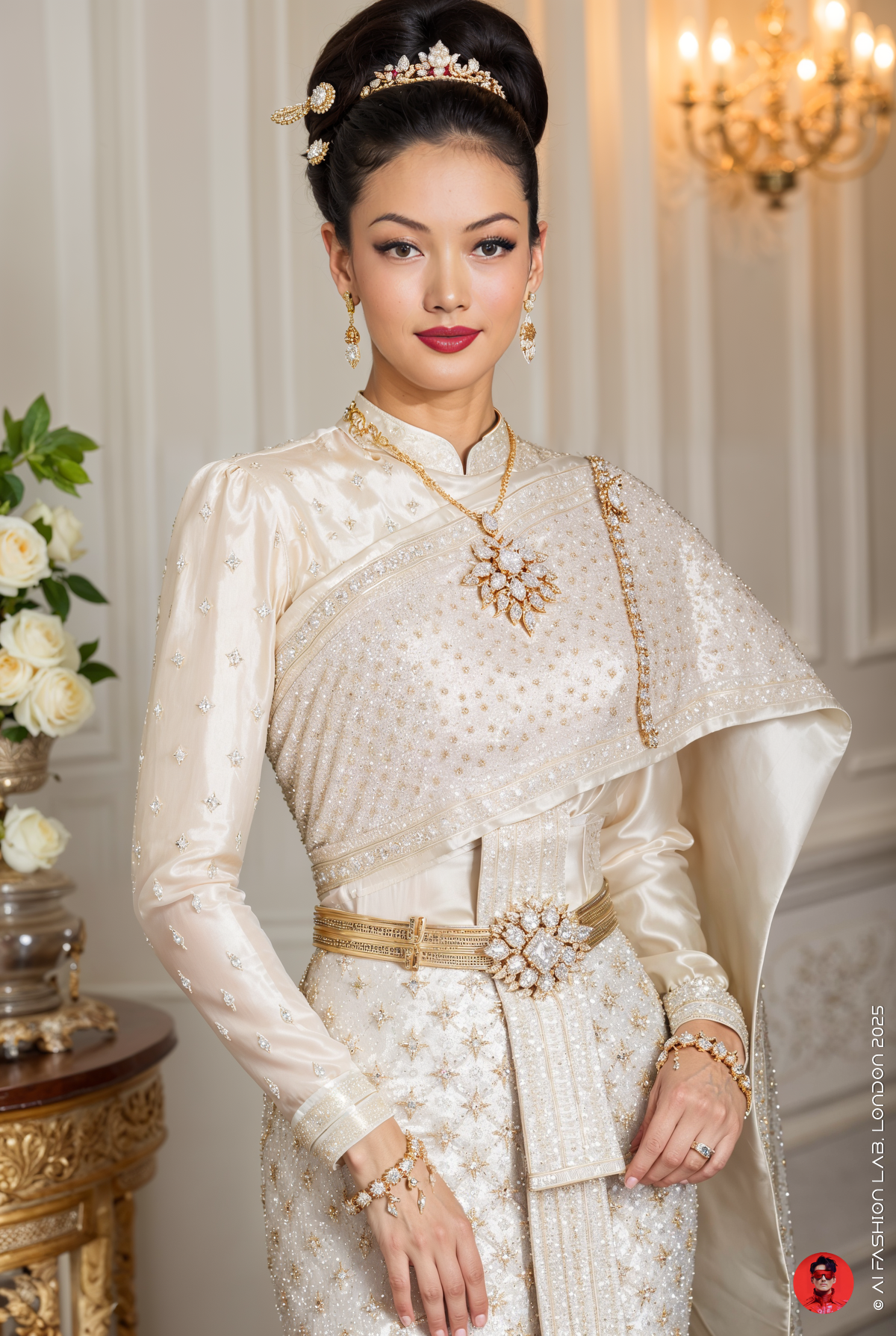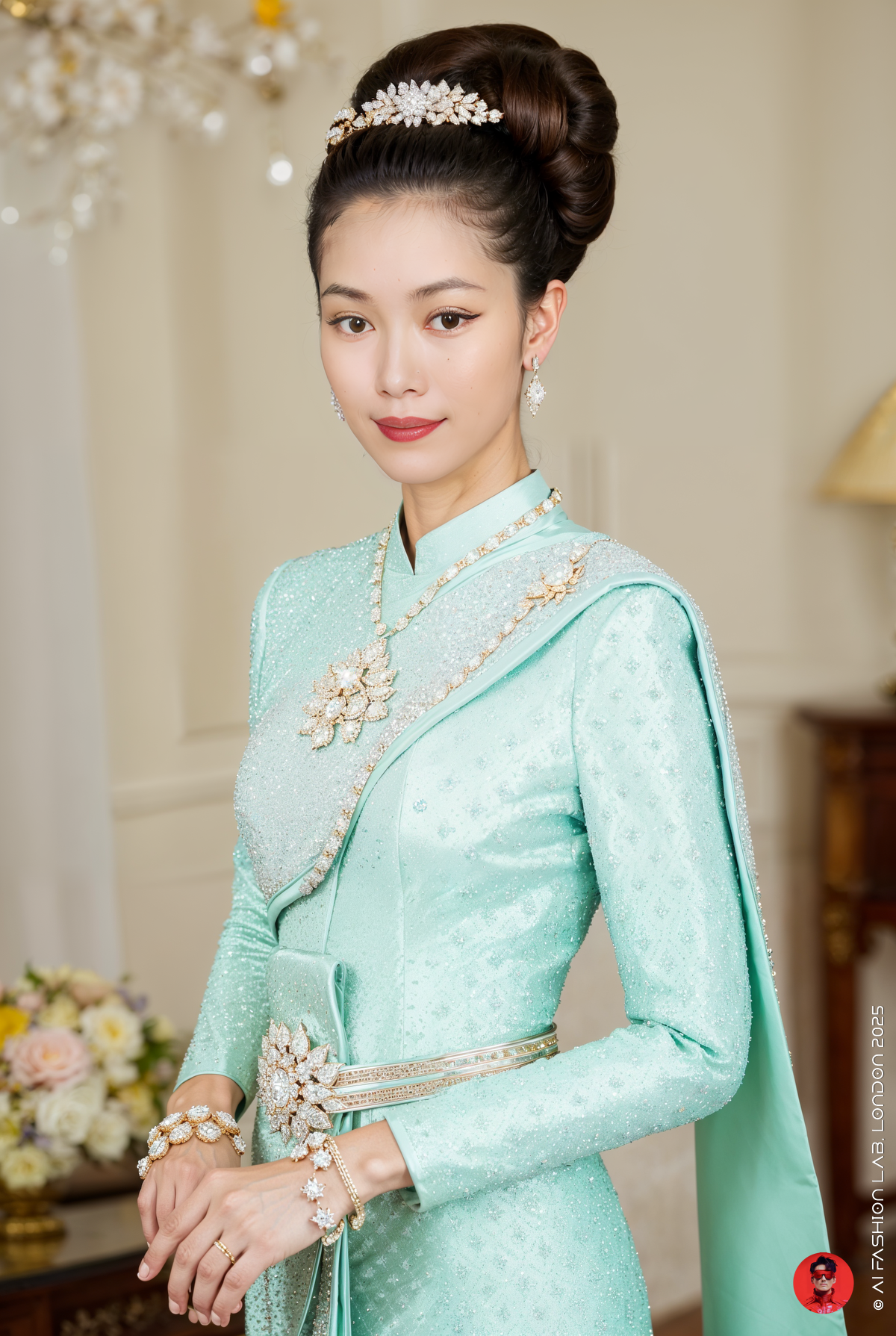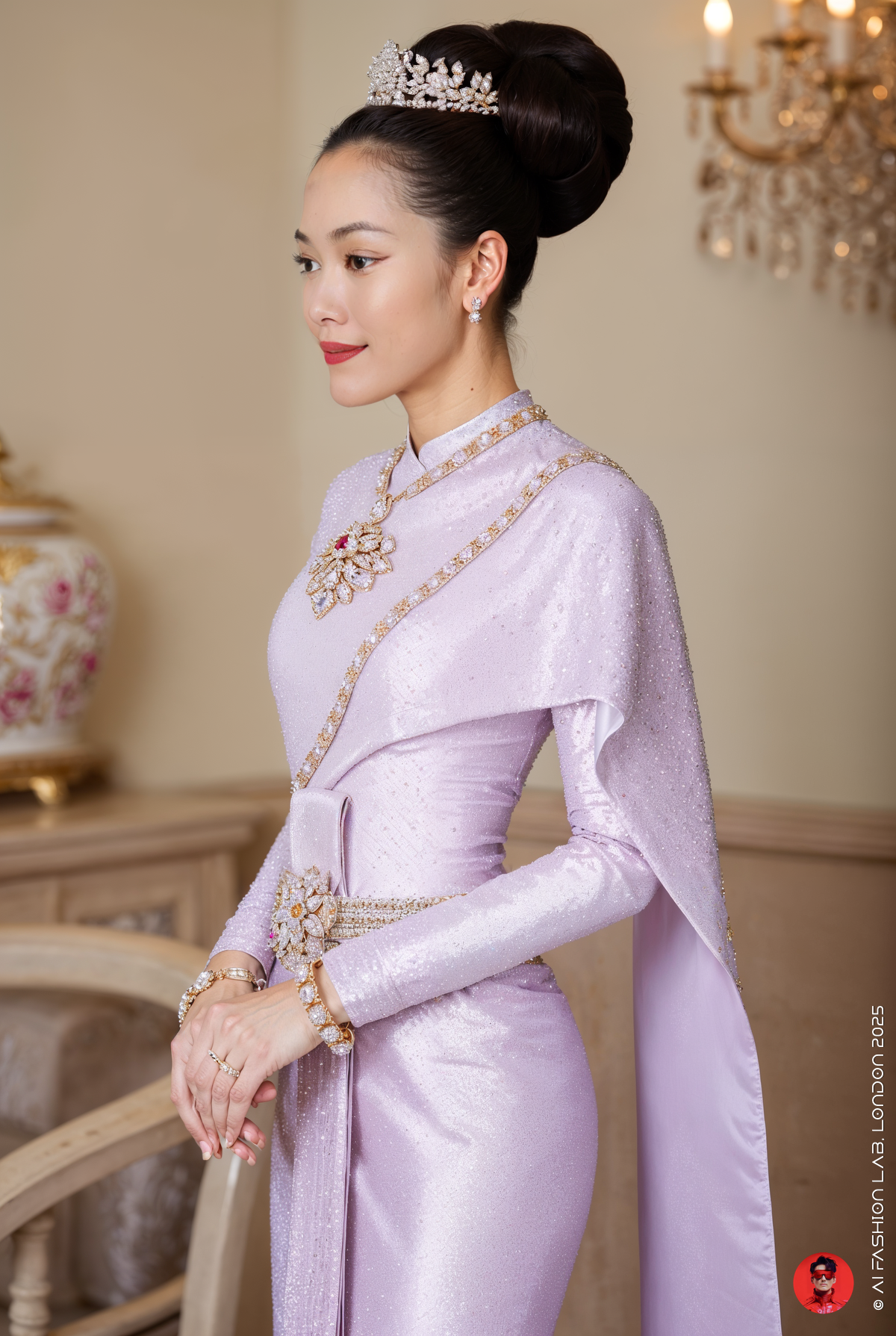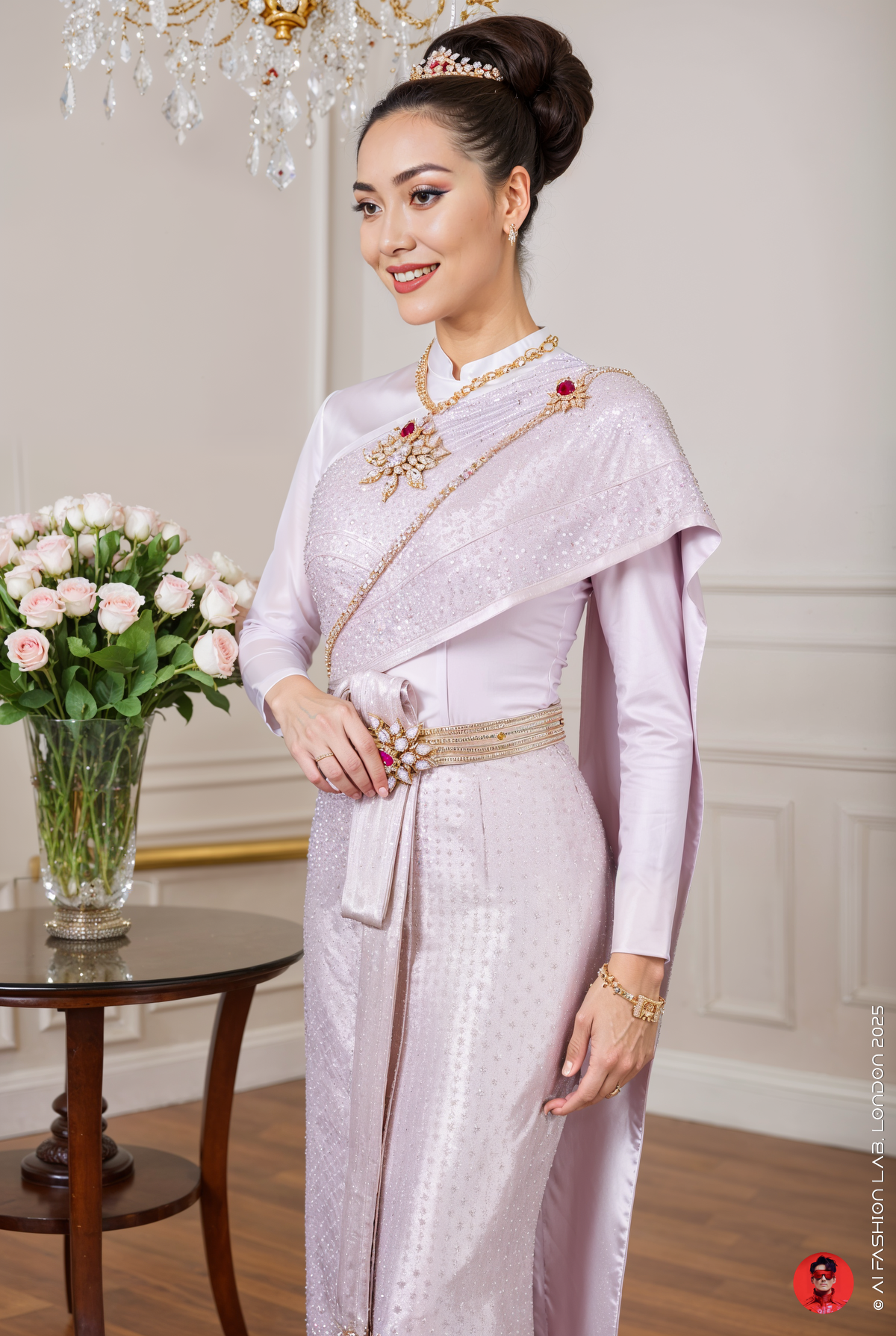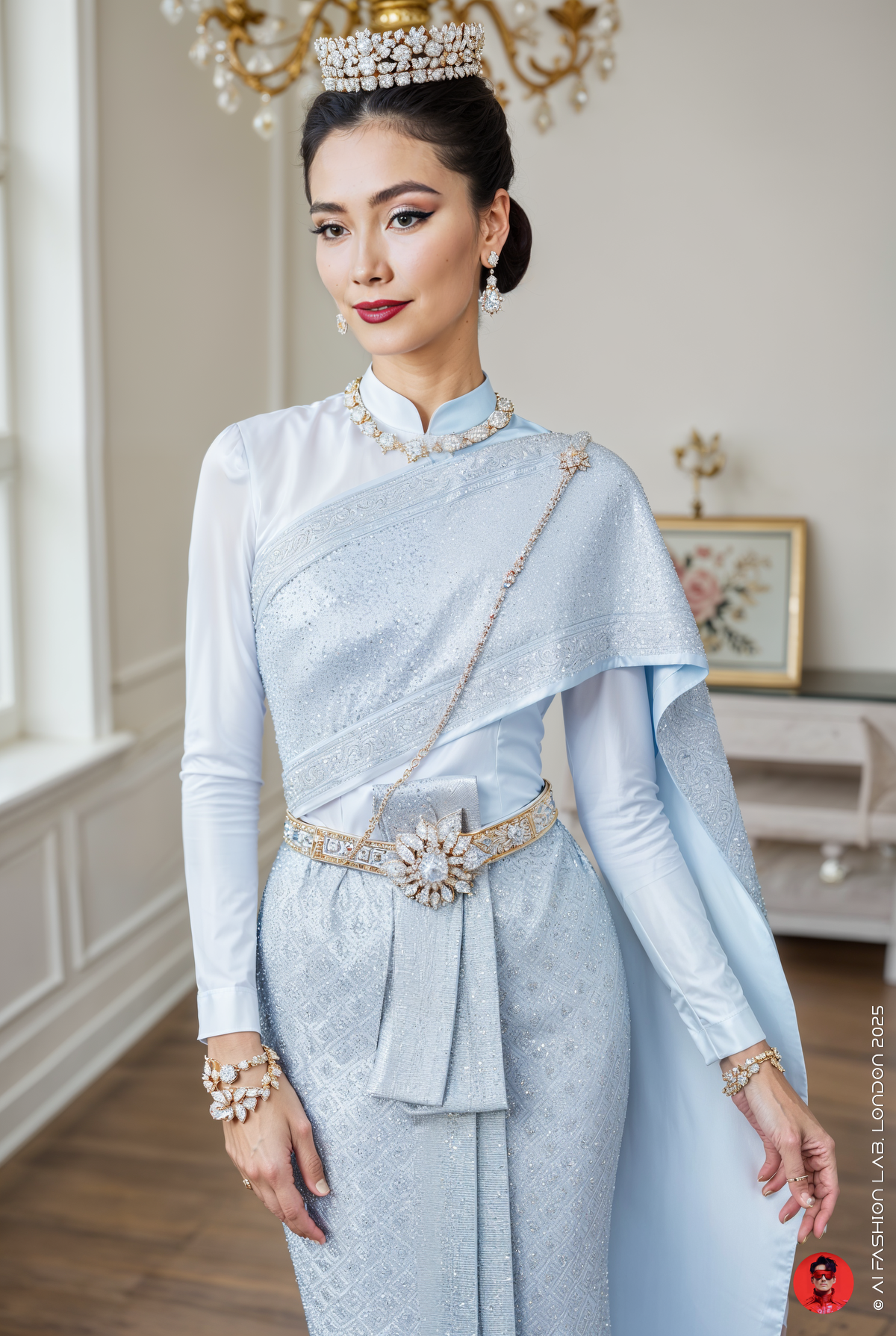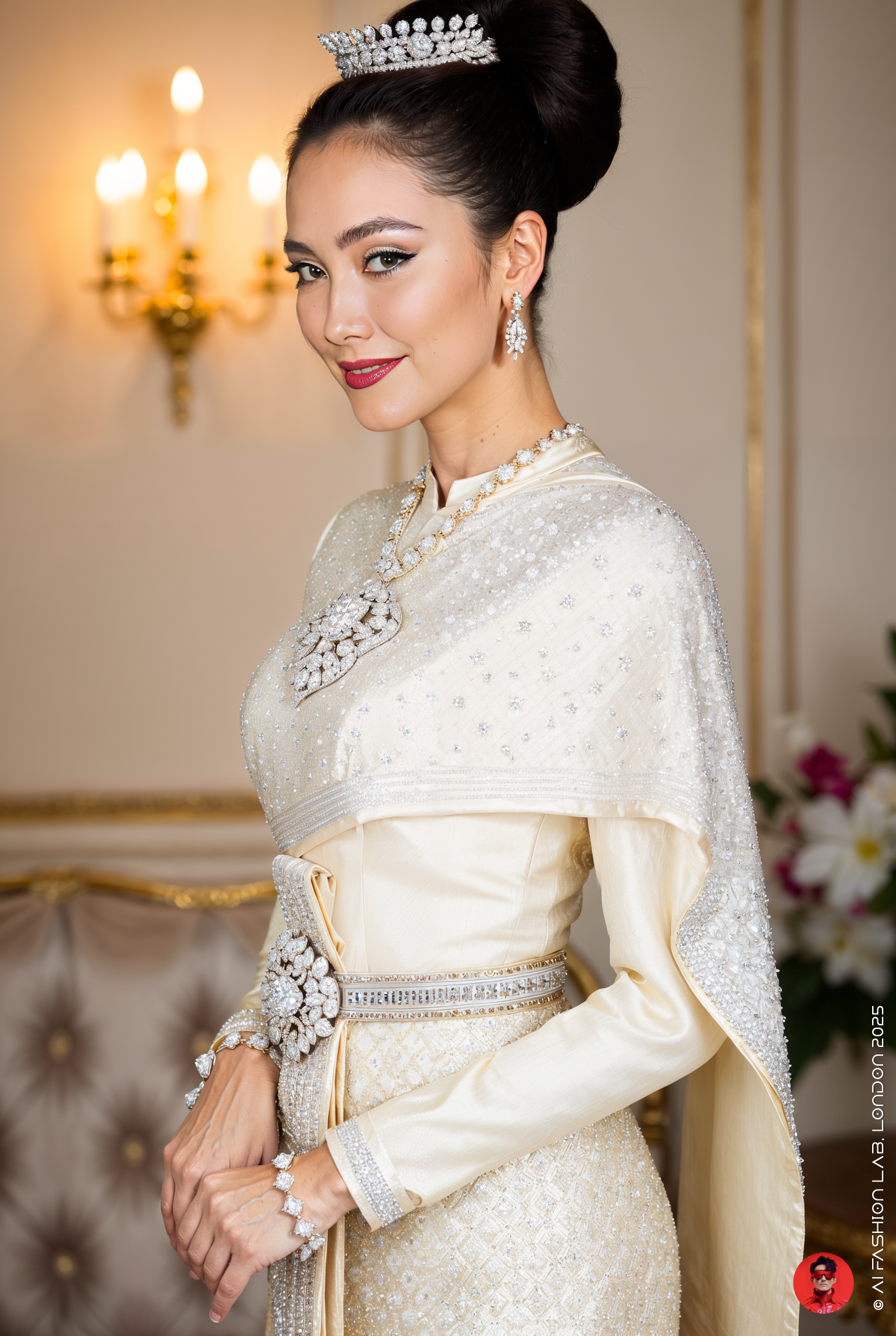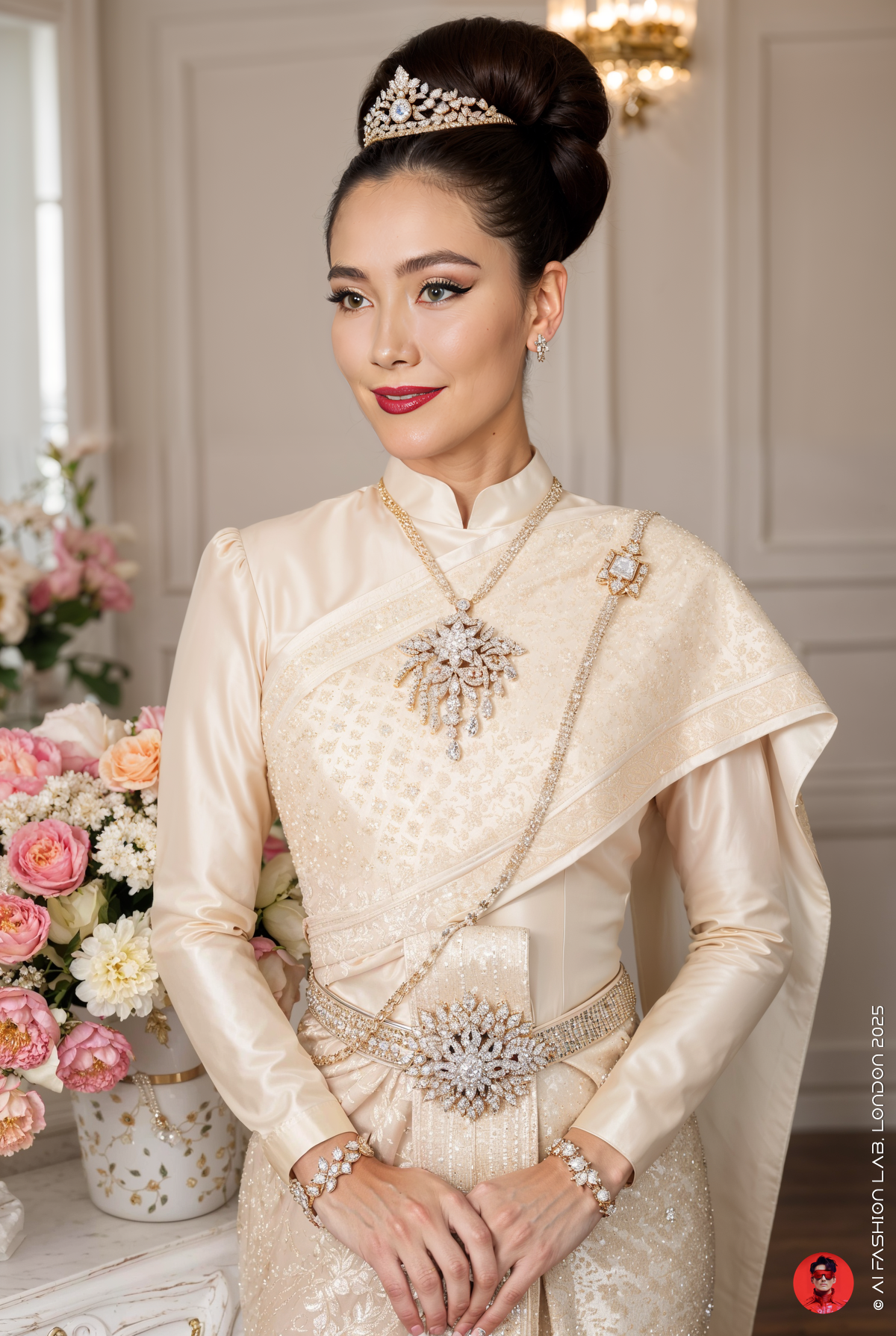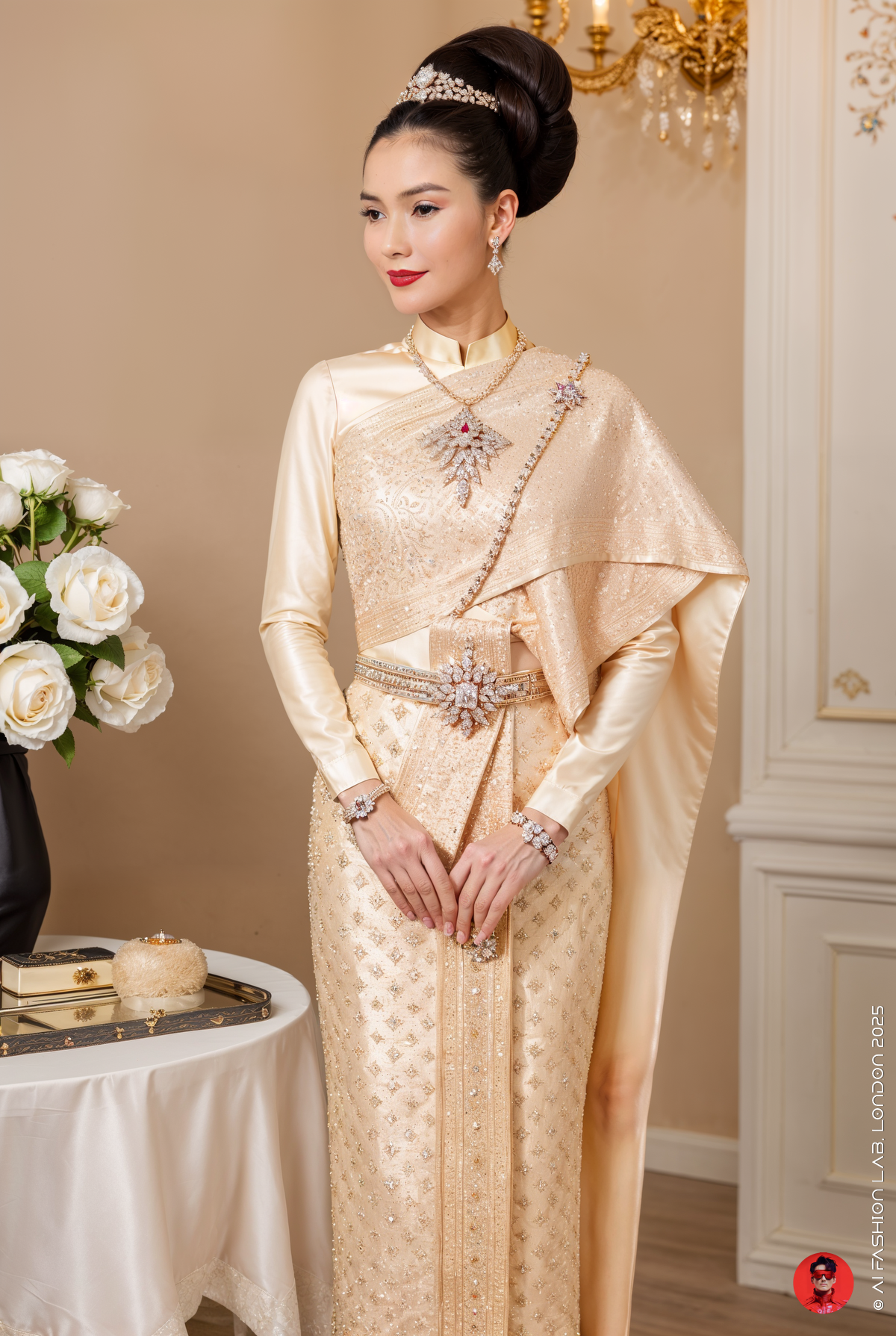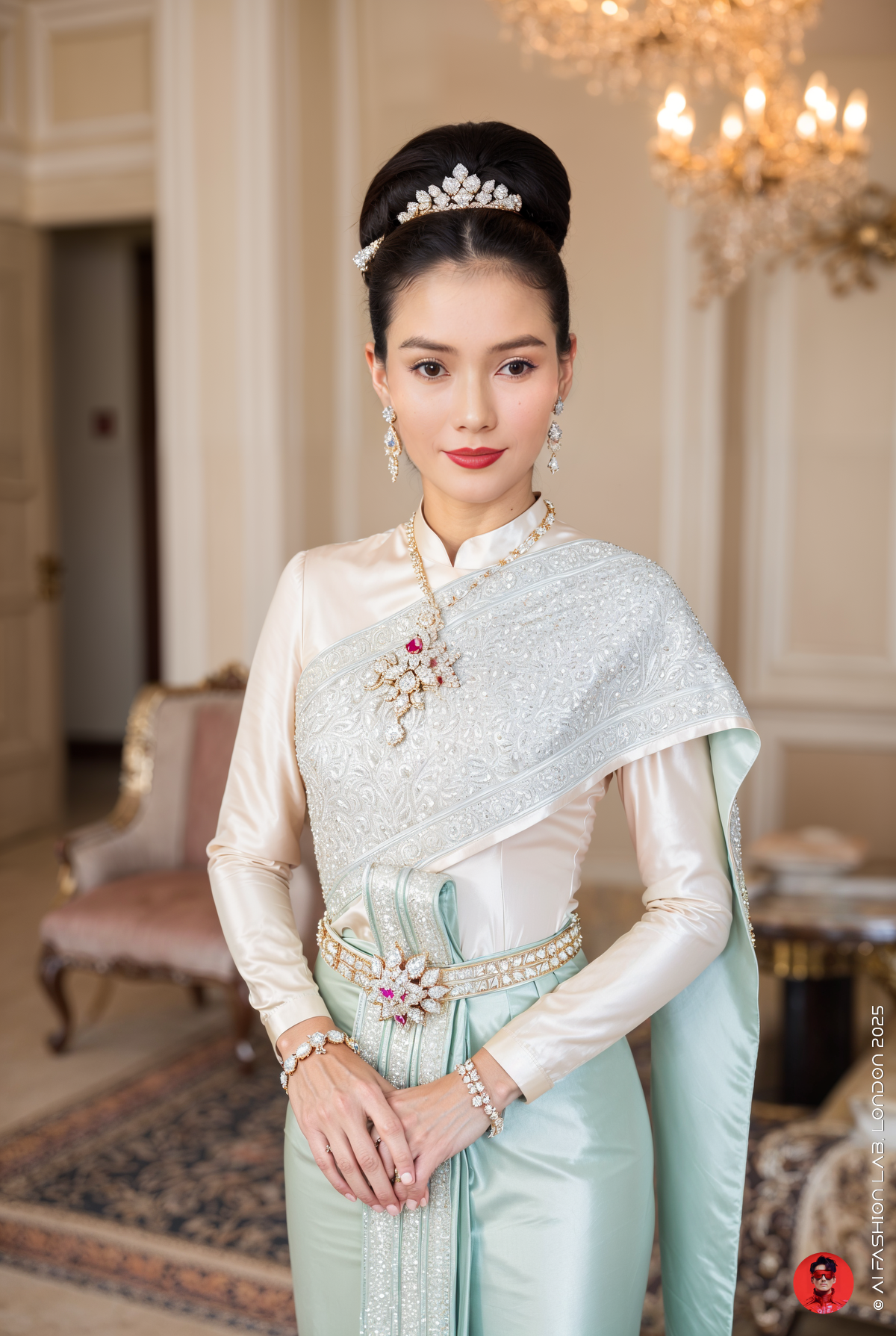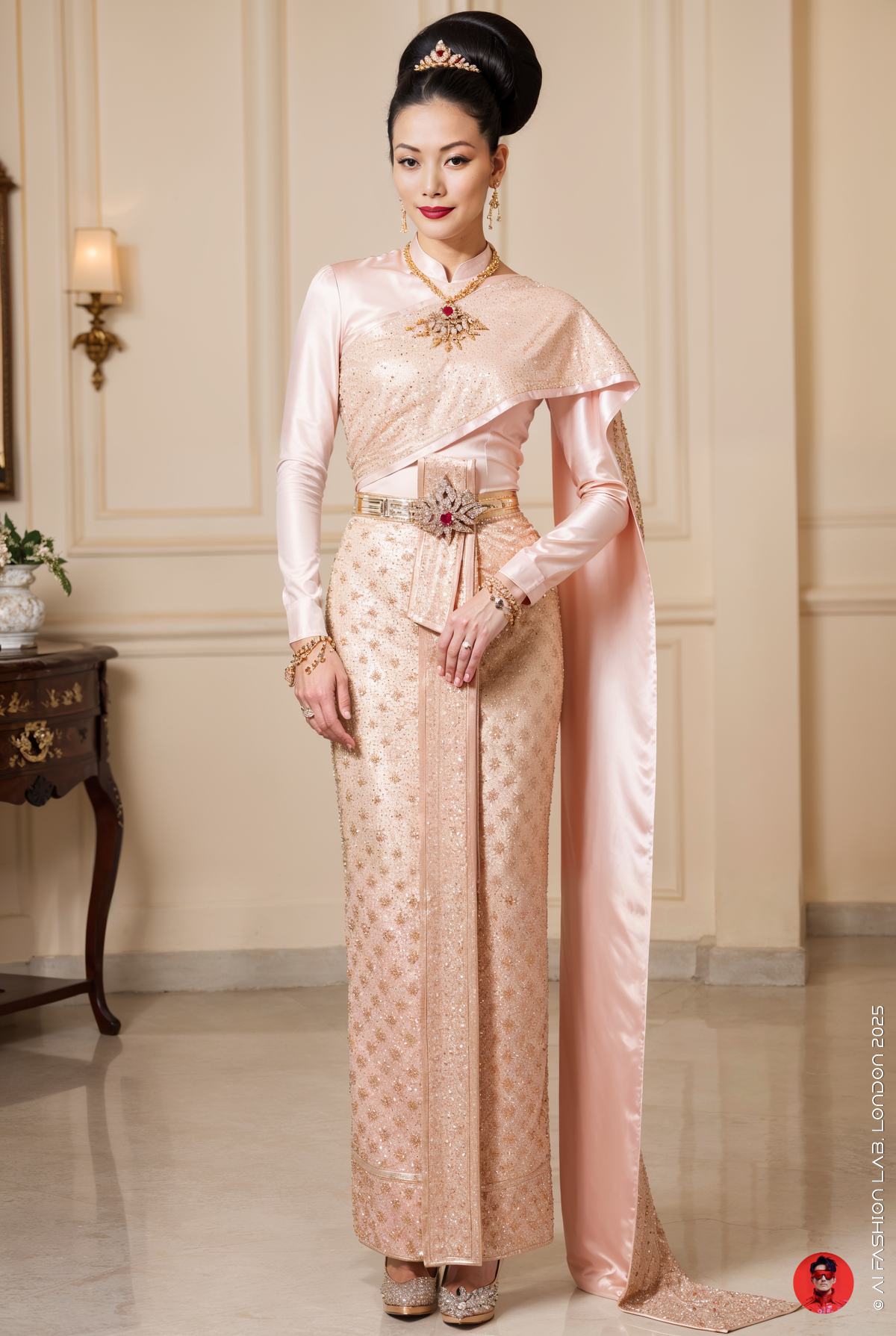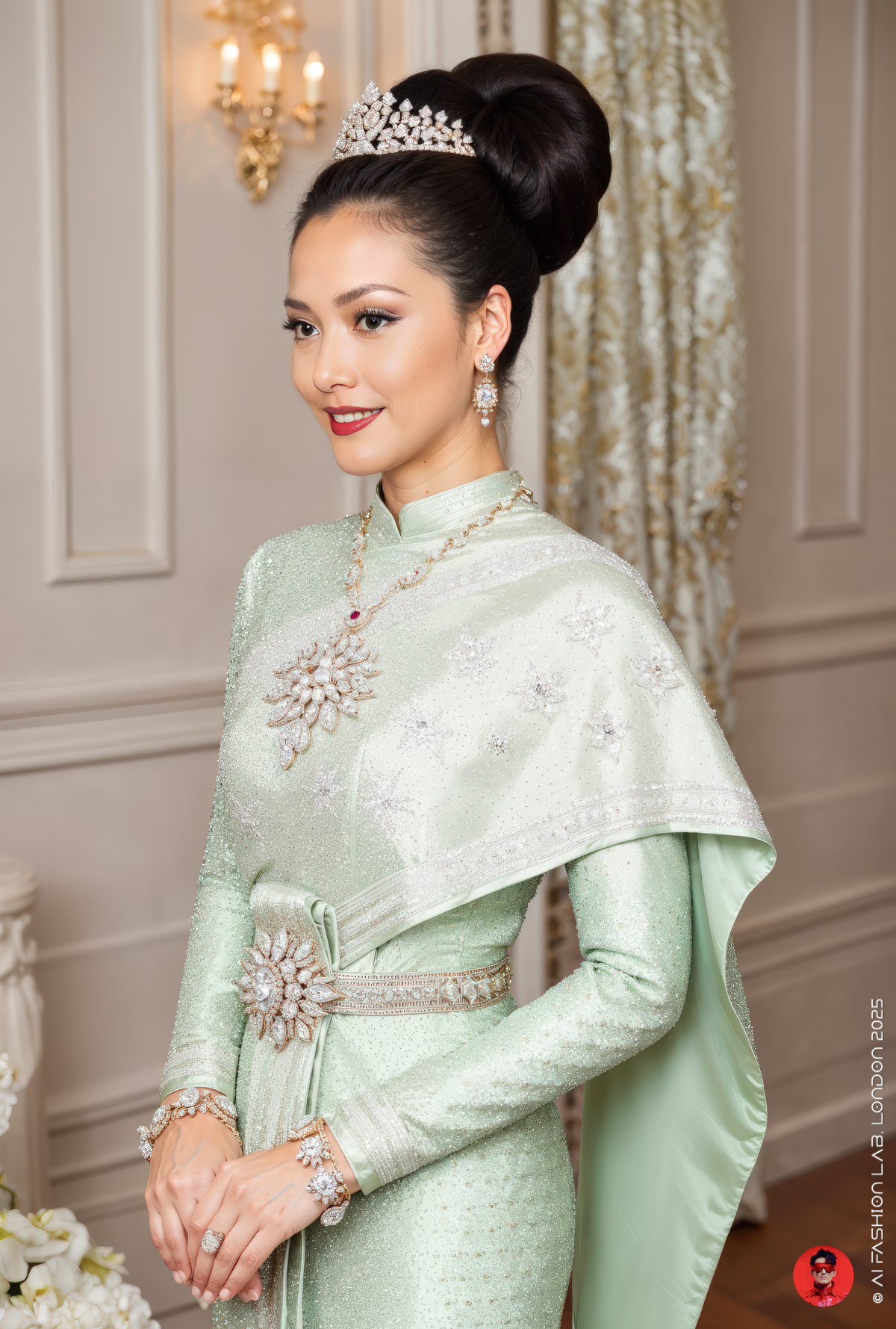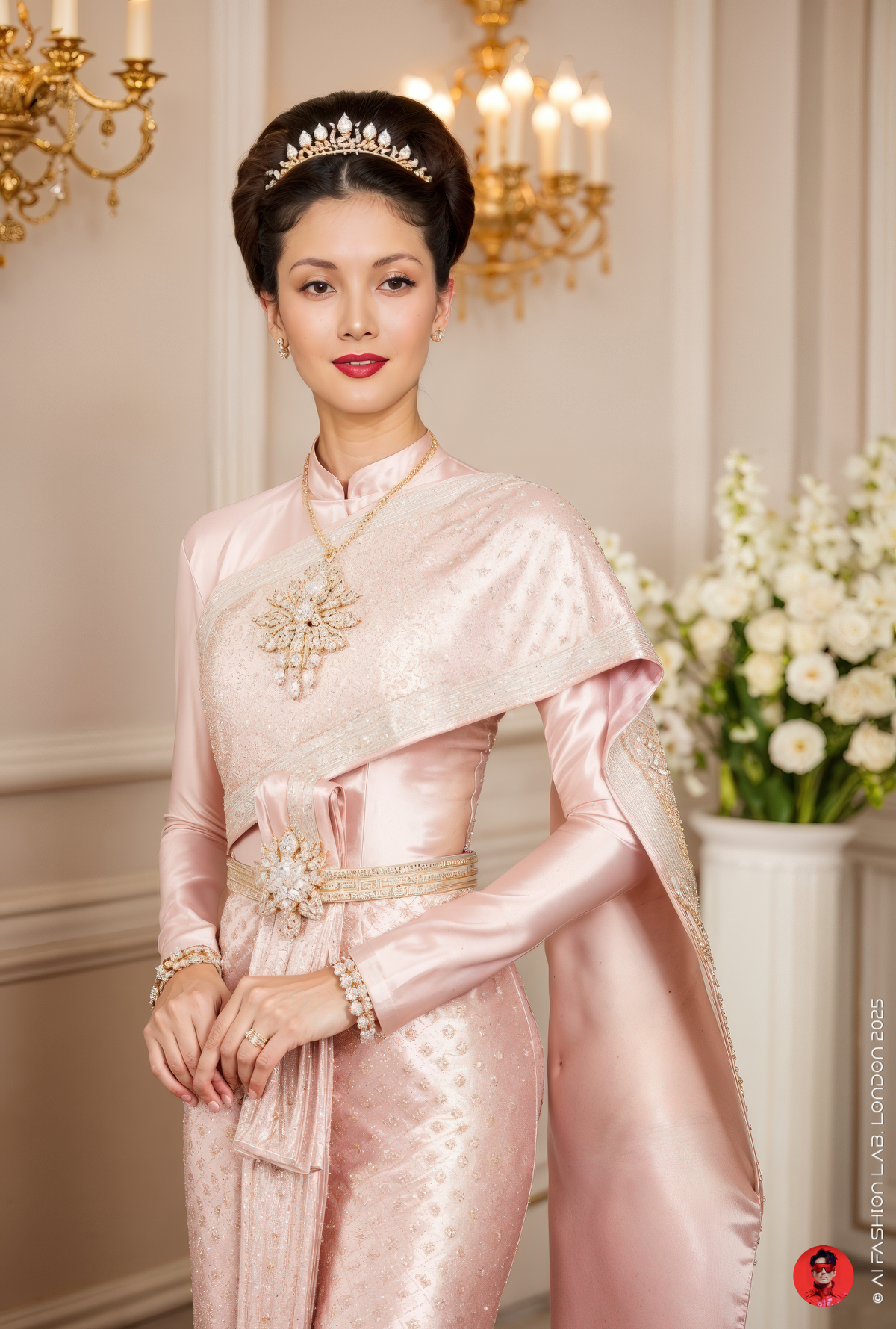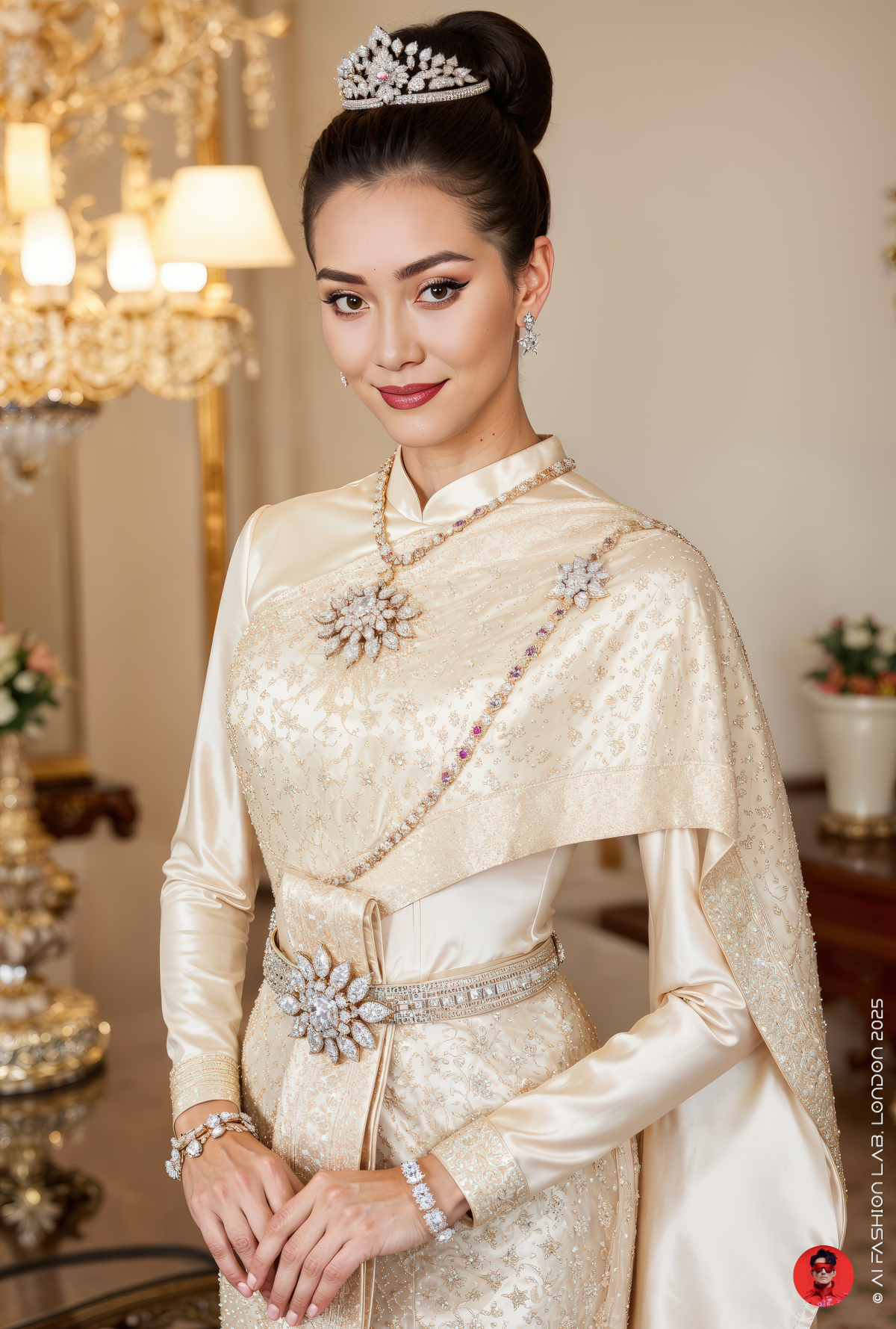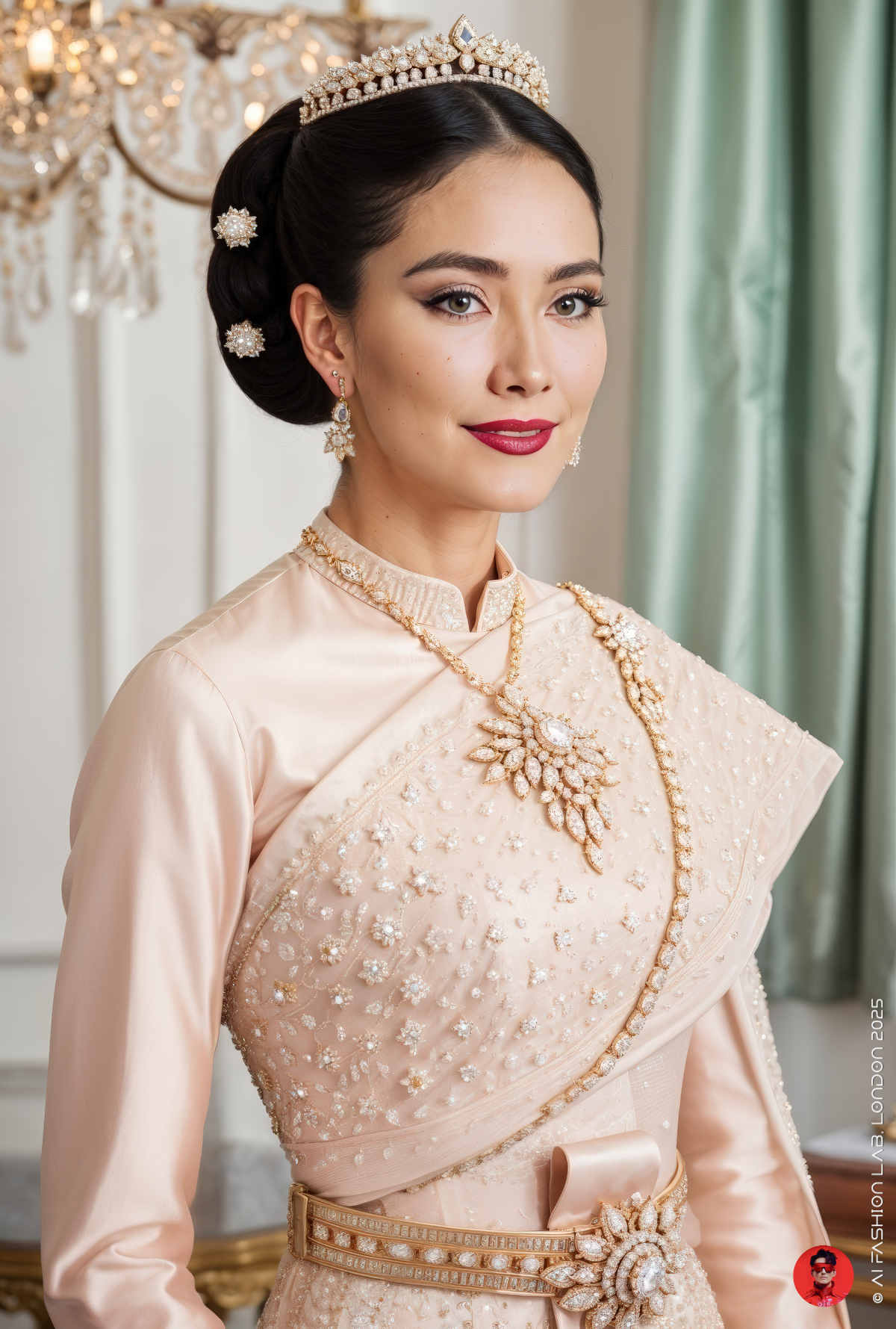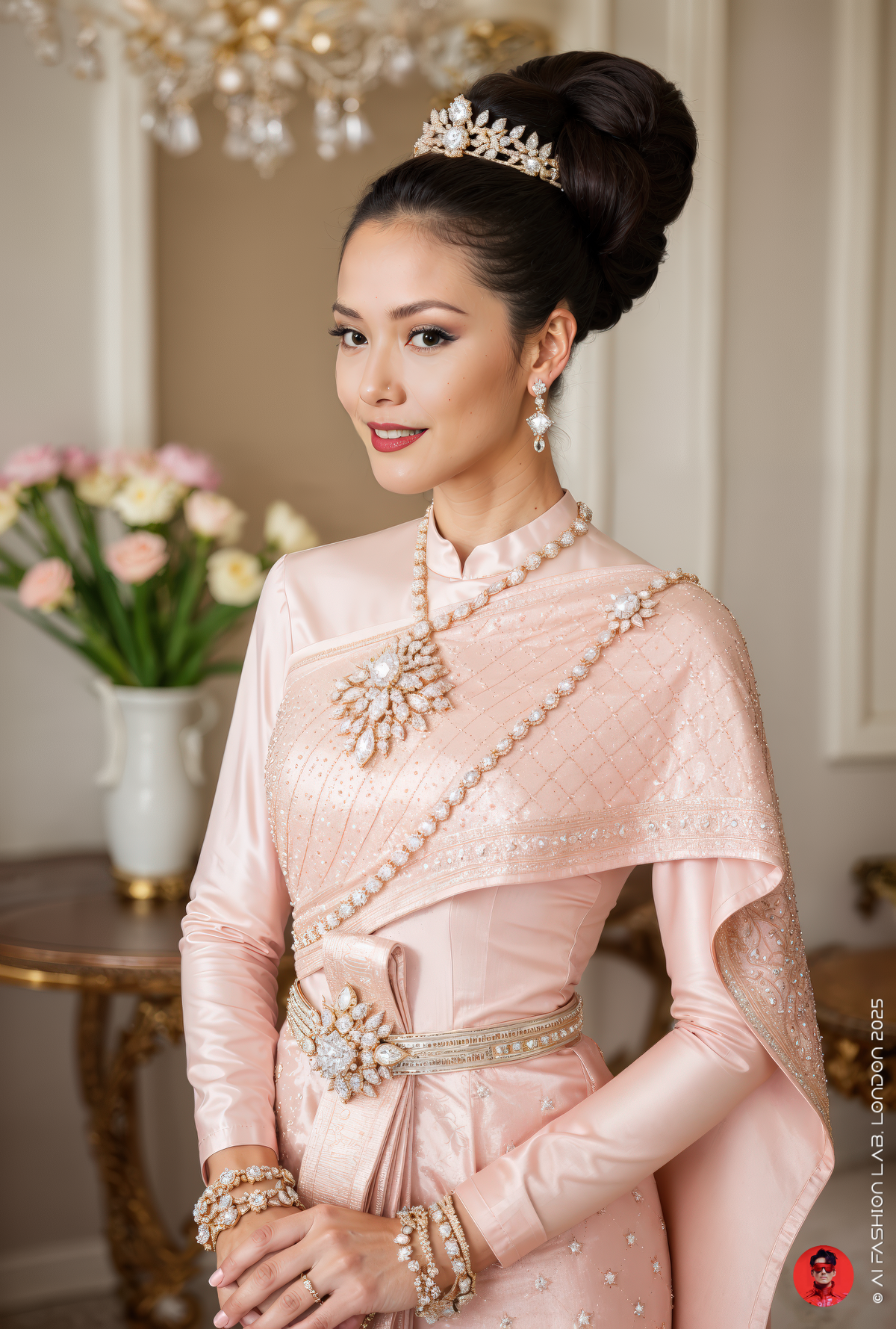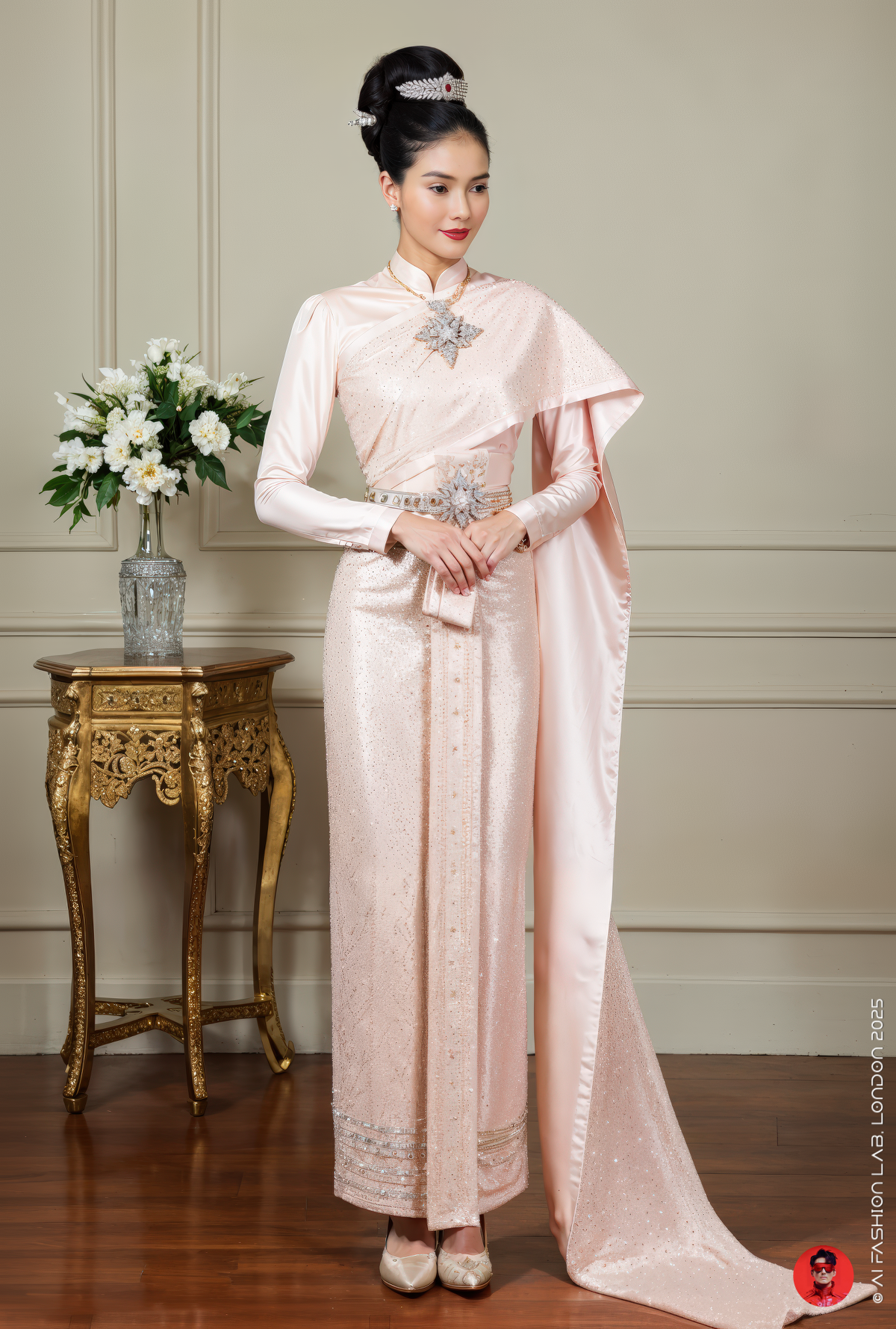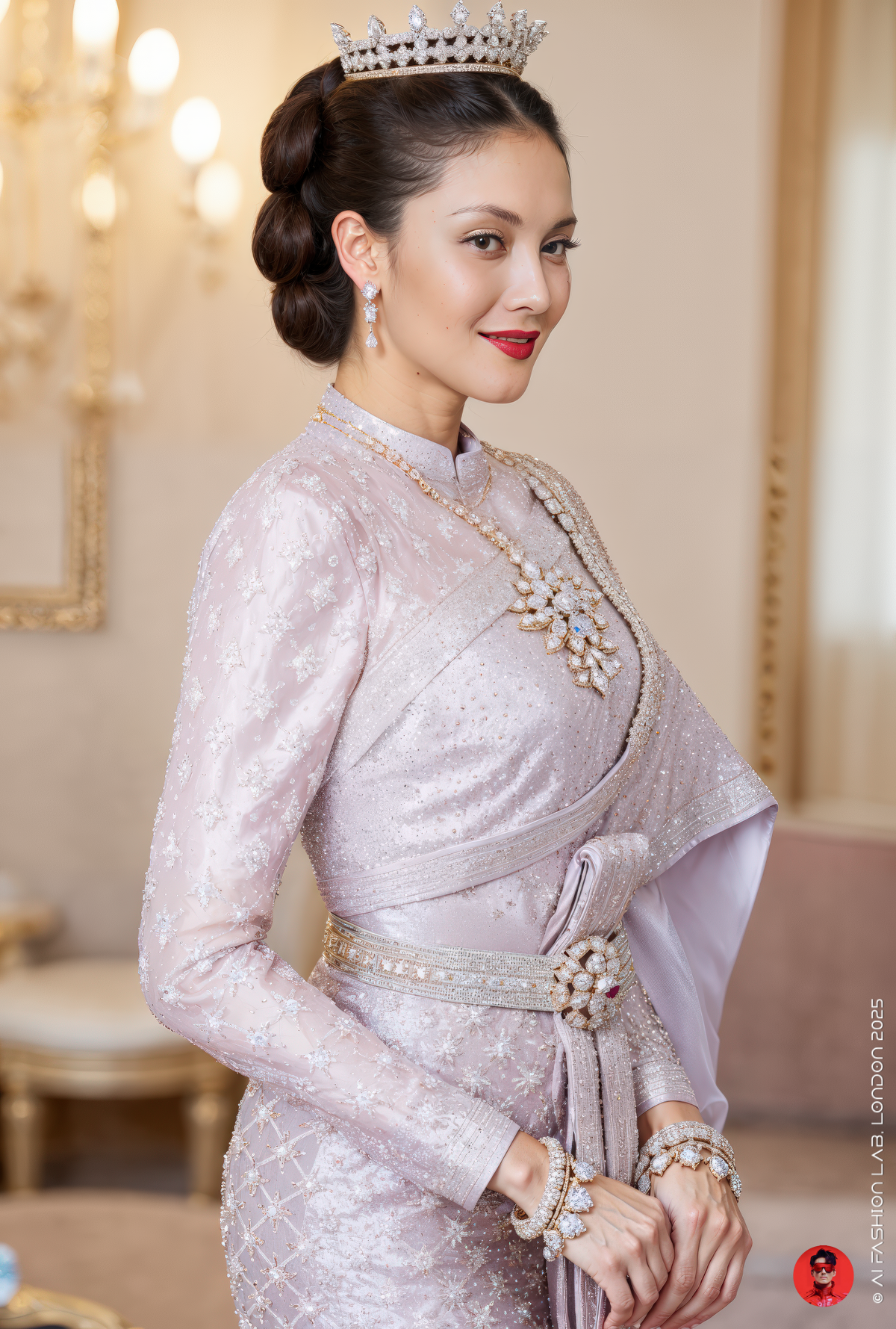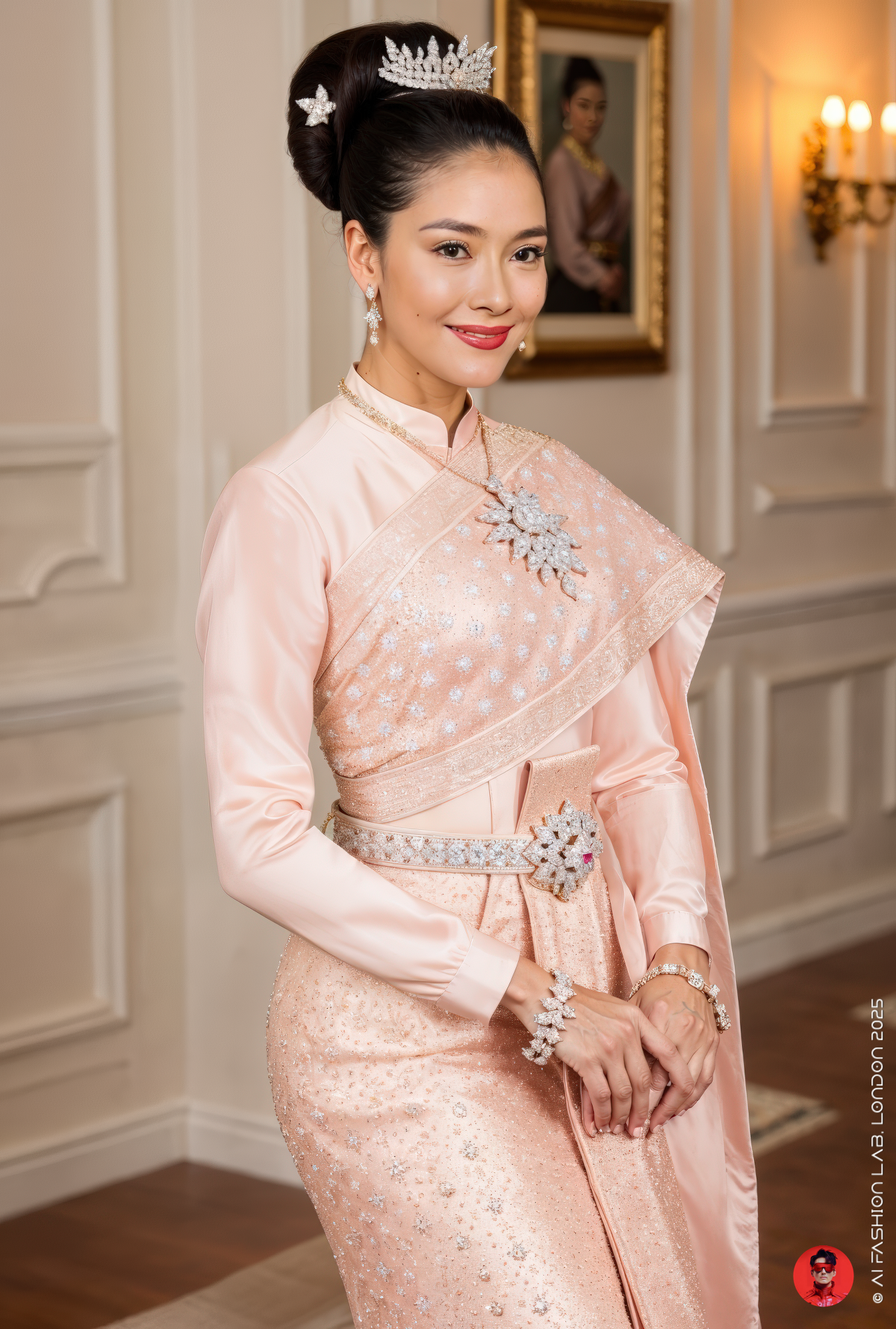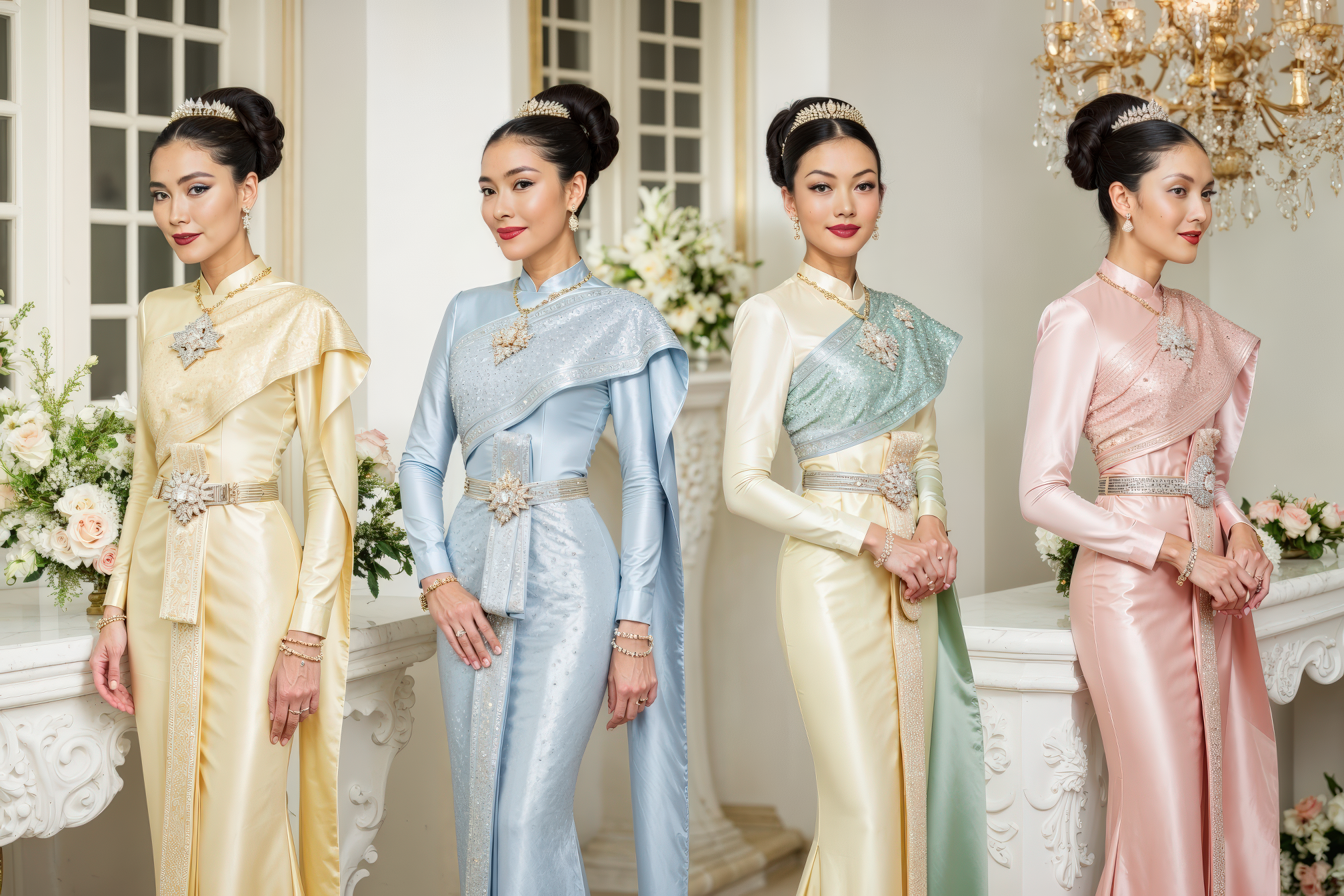ชุดไทยศิวาลัย ชุดไทยพระราชนิยม เครื่องแต่งกายประจำชาติและความภาคภูมิใจในความเป็นไทย (๖ ใน ๘)
ชุดไทยศิวาลัย ชุดไทยพระราชนิยม เครื่องแต่งกายประจำชาติและความภาคภูมิใจในความเป็นไทย (ชุดแบบที่ 6 จากทั้งหมด 8 แบบในชุดไทยพระราชนิยม)
ชุดไทยศิวาลัย เป็นหนึ่งใน ชุดไทยพระราชนิยม ซึ่งสมเด็จพระนางเจ้าสิริกิติ์ พระบรมราชินีนาถ พระบรมราชชนนีพันปีหลวง ทรงพระกรุณาโปรดเกล้าฯ ให้รังสรรค์ขึ้น เพื่อเป็นต้นแบบของเครื่องแต่งกายที่สะท้อนเอกลักษณ์ความเป็นไทยอย่างวิจิตรบรรจง ทั้งยังผสานความละเมียดละไมเข้ากับรสนิยมสากลของโลกยุคทศวรรษ 1960 ได้อย่างลงตัว
ชุดไทยศิวาลัยมีความงดงามอ่อนช้อย และเป็นทางการ ชุดนี้ตั้งชื่อตามพระที่นั่ง “ศิวาลัย” โดยเดิมทีเป็นเครื่องแต่งกายของสตรีสูงศักดิ์ มักสวมใส่ในงานพระราชพิธี รัฐพิธี หรือโอกาสสำคัญอื่น ๆ อาทิ งานเลี้ยง งานหมั้น หรืองานฉลองมงคลสมรส ลักษณะของชุดประกอบด้วย เสื้อแขนยาวจรดข้อมือ คอกลมขอบตั้งเล็กน้อย ห่มทับด้วยสไบเฉียงปักลวดลายไทยอย่างประณีต ส่วนของผ้านุ่งเป็นซิ่นตัดแบบหน้านาง มีชายพก และเย็บติดกับตัวเสื้อ คาดเอวด้วยเข็มขัดเงินหรือทอง อีกทั้งนิยมประดับเครื่องแต่งกายเพิ่มเติมตามความเหมาะสม เช่น ต่างหู สร้อยคอ สร้อยข้อมือ สังวาล เป็นต้น ช่วยเสริมเสน่ห์และคงไว้ซึ่งเอกลักษณ์ของความเป็นไทยได้อย่างงดงาม
ความแตกต่างระหว่างชุดไทยศิวาลัย กับชุดไทยบรมพิมาน
ทั้งชุดไทยศิวาลัยและชุดไทยบรมพิมานต่างก็มีลักษณะเป็นเสื้อแขนยาวทรงกระบอกเช่นเดียวกัน ทำให้หลายคนเกิดความสับสนและแยกไม่ออก ความแตกต่างสำคัญคือ ชุดไทยศิวาลัยจะห่มสไบทับอีกชั้นหนึ่ง ขณะที่ ชุดไทยบรมพิมานจะไม่มีสไบห่มทับนั่นเอง
สำหรับผลงาน AI Collection ชุดนี้ ผมได้ออกแบบชุดไทยศิวาลัยโดยเลือกใช้ผ้าไหมปักดิ้นเงินทั้งชุด ในโทนสีพาสเทลเป็นหลัก ตกแต่งด้วยเครื่องประดับไทย อาทิ เครื่องเพชรโบราณ เทียร่า หรือมงกุฎแบบตะวันตกขนาดเล็ก เพื่อสื่อถึงความอ่อนหวาน อ่อนโยน และสง่างามของผู้สวมใส่ เหมาะสำหรับโอกาสยามค่ำคืน ทั้งในงานแต่งงาน งานเลี้ยงราตรี หรือราชพิธีที่ต้องการความเรียบหรูและมีระดับ
นอกจากนี้ ผมยังตั้งใจออกแบบให้คอลเลกชันนี้มีกลิ่นอายวินเทจ โดยย้อนบรรยากาศกลับไปในยุค 1960 ซึ่งเป็นช่วงเวลาที่ ชุดไทยพระราชนิยม ได้รับการรังสรรค์ขึ้น โดยสามารถสังเกตได้จากทรงผมแบบตีพองและมวยสูง หรือทรง บุพฟอง (bouffant) ซึ่งเป็นสไตล์ยอดนิยมในยุคนั้น
กล่าวได้ว่า ชุดไทยศิวาลัย คือการผสมผสานอย่างงดงามระหว่างความวิจิตรแห่งเครื่องแต่งกายไทยดั้งเดิม กับแนวคิดร่วมสมัยในโลกสากล อีกทั้งยังเป็นต้นแบบอันเหมาะสมยิ่งสำหรับการสร้างสรรค์ด้วยเทคโนโลยี AI ภายใต้แนวคิด “ความสง่างามแบบวินเทจสไตล์ไทย” ที่หลอมรวมกลิ่นอายอดีต ความร่วมสมัย และคุณค่าทางวัฒนธรรมเข้าไว้ด้วยกันอย่างกลมกลืน
นอกจากนี้ AI Collection ชุดนี้ยังได้รับแรงบันดาลใจจาก สมเด็จพระนางเจ้าสิริกิติ์ พระบรมราชินีนาถ พระบรมราชชนนีพันปีหลวง และ ชุดไทยพระราชนิยมทั้ง 8 แบบ ซึ่งทรงมีพระราชดำริจัดสร้างขึ้นระหว่างปี พ.ศ. 2503–2504 เพื่อให้สตรีไทยมีเครื่องแต่งกายที่สง่างาม สะท้อนเอกลักษณ์ของความเป็นไทย และเหมาะสมกับงานพิธีและโอกาสสำคัญต่าง ๆ
เพื่อเฉลิมพระเกียรติในพระราชดำริอันทรงคุณค่านี้ ผมจึงสร้างสรรค์ AI Collection ที่นำเสนอชุดไทยทั้ง 8 แบบผ่านมุมมองร่วมสมัย โดยผสมผสานกลิ่นอายแฟชั่นวินเทจแห่งยุค 1960s ซึ่งเป็นช่วงเวลาเดียวกับการกำเนิดของชุดเหล่านี้ ทั้งการจัดแสง ทรงผม และองค์ประกอบในภาพ ต่างได้รับการออกแบบอย่างประณีตเพื่อสะท้อนความงดงามของช่วงเวลาแห่งวัฒนธรรมไทยนี้อย่างสมบูรณ์
ในปีหน้า องค์การยูเนสโก (UNESCO) มีแนวโน้มจะขึ้นทะเบียน "ชุดไทยพระราชนิยม" เป็นมรดกภูมิปัญญาทางวัฒนธรรมของโลก โครงการนี้จึงมุ่งหวังที่จะเฉลิมฉลอง อนุรักษ์ และส่งต่อความภูมิใจในความเป็นไทยไปสู่คนรุ่นต่อไป
พระราชนิยมในการใช้ผ้าไทย: พระปณิธานของสมเด็จพระนางเจ้าฯ พระบรมราชินีนาถ
สมเด็จพระนางเจ้าฯ พระบรมราชินีนาถ ทรงมีพระราชนิยมในการใช้ ผ้าไทย มาตั้งแต่ยังทรงพระเยาว์ เมื่อครั้งสมเด็จพระเจ้าอยู่หัวมีพระราชดำริจะทรงประกาศหมั้น นักหนังสือพิมพ์ต่างประเทศได้ขอสัมภาษณ์พระองค์ ซึ่งพระองค์ทรงตอบอย่างชัดเจนว่า จะสนับสนุนและส่งเสริมการแต่งกายแบบไทย
ในโอกาสนั้น พระองค์ในฐานะ “พระคู่หมั้น” ทรงเลือกใช้ ผ้าไหมไทย และ ซิ่นไทย สำหรับชุดต่าง ๆ รวมถึง ฉลองพระองค์ในพระราชพิธีอภิเษกสมรส ก็ทรงใช้ผ้าไทยอย่างภาคภูมิ ภายหลังจากพระราชพิธีดังกล่าว พระองค์ทรงยึดมั่นในพระราชปณิธาน และทรงพระกรุณาโปรดให้สร้าง “เครื่องแต่งกายแบบไทยตามพระราชนิยม” ขึ้น จนกลายเป็น เครื่องแต่งกายประจำชาติของสตรีไทย มาจนถึงปัจจุบัน
ในสมัยที่เสด็จฯ เยือนประเทศเพื่อนบ้านเป็นครั้งแรก ยังไม่มีการกำหนดชุดไทยตามแบบพระราชนิยม พระองค์จึงทรงริเริ่มออกแบบฉลองพระองค์โดยใช้ ผ้าไหมไทย ผ้ายก และผ้าพื้นถิ่นไทย ต่าง ๆ มาตัดเย็บและประดิษฐ์ตกแต่ง เพื่อให้สื่อถึงอัตลักษณ์ของความเป็นไทย โดยทรงเจริญรอยตามสมเด็จพระพันปีหลวง สมเด็จพระศรีพัชรินทรา บรมราชินีนาถ
ชุดไทยพระราชนิยม
“ชุดไทยพระราชนิยม” หมายถึง ชุดแต่งกายประจำชาติของสตรีไทยที่ใช้ในงานพิธี งานมงคลสมรส และโอกาสสำคัญต่าง ๆ ชุดเหล่านี้มีลักษณะเฉพาะทางด้านรูปแบบ วัสดุ และการตกแต่ง โดยนิยมใช้ผ้าไหม ผ้าฝ้าย หรือผ้าใยประดิษฐ์ เช่น ผ้าพื้น ผ้าลายดอก ผ้าลายริ้ว ผ้ายกดิ้นเงิน ดิ้นทอง หรือผ้ายกดอกทั้งผืน พร้อมตกแต่งด้วยซิป ตะขอ หรือกระดุมที่หุ้มด้วยผ้า และอาจปักมุก เลื่อม หรือใช้ลูกปัดตกแต่งเพื่อเพิ่มความสง่างาม
ประเภทผ้าที่นิยมใช้ เช่น:
ผ้าไหม: ทอจากเส้นด้ายที่ได้จากใยไหม
ผ้าฝ้าย: ทอจากเส้นด้ายฝ้ายธรรมชาติ
ผ้าใยประดิษฐ์: ผ้าใยสังเคราะห์ เช่น โพลีเอสเตอร์ เรยอน เจอร์ซีย์ หรือโทเร
ชุดไทยพระราชนิยมทั้ง 8 แบบ ได้แก่
ชุดไทยเรือนต้น – เรียบง่าย เหมาะสำหรับงานไม่เป็นทางการหรือสวมใส่ในชีวิตประจำวัน
ชุดไทยจิตรลดา – สุภาพ เหมาะสำหรับงานพิธีการเล็กน้อยหรือรับรองแขก
ชุดไทยอมรินทร์ – งดงาม เหมาะกับงานราตรีหรืองานพิธีสำคัญ
ชุดไทยบรมพิมาน – ผ้าไหมลายสวย ใช้ในงานพิธีการและงานทางการ
ชุดไทยจักรี – หรูหรา สง่างาม เหมาะกับงานพิธีระดับสูง
ชุดไทยดุสิต – ใช้ผ้าไหมลวดลาย ปักลายวิจิตร สำหรับงานราตรีหรืองานฉลอง
ชุดไทยศิวาลัย – หรูหรา เน้นเครื่องประดับ ใช้ในงานพิธีสำคัญ
ชุดไทยจักรพรรดิ์ – สง่างามที่สุด ใช้ในงานพิธีใหญ่ระดับราชสำนัก
Chud Thai Siwalai – Chud Thai Phra Ratcha Niyom – National Dress and a Symbol of Thai Identity
(Style No. 6 of the 8 official designs in the Chud Thai Phra Ratcha Niyom collection)
Chud Thai Siwalai (ชุดไทยศิวาลัย) is one of the eight officially recognised styles of Chud Thai Phra Ratcha Niyom (ชุดไทยพระราชนิยม), graciously initiated by Her Majesty Queen Sirikit, The Queen Mother. It was created as a prototype of formal Thai dress that reflects the intricacy and elegance of Thai identity while harmonising beautifully with international fashion sensibilities of the 1960s.
The Chud Thai Siwalai (ชุดไทยศิวาลัย) is known for its refined beauty and captivating presence. Named after the Siwalai Throne Hall (พระที่นั่งศิวาลัย), this style was traditionally worn by noblewomen for formal occasions, including royal ceremonies, state events, receptions, engagement celebrations, and weddings.
The outfit consists of a long-sleeved blouse that reaches the wrists, featuring a round neckline with a slightly raised collar. It is draped with a sabai (สไบ) worn diagonally across the shoulder, often embroidered in intricate Thai patterns. The lower part is a sinh (ซิ่น), a traditional Thai tube skirt sewn into the blouse, tailored in the Na Nang (หน้านาง) style with a pleated front and chai pok (ชายพก) panel. A silver or gold belt is worn around the waist. The ensemble is often completed with traditional Thai jewellery such as earrings, necklaces, bracelets, and a ceremonial chain (sangwan – สังวาล), enhancing its elegance and firmly preserving Thai cultural identity.
Difference Between Chud Thai Siwalai (ชุดไทยศิวาลัย) and Chud Thai Boromphiman (ชุดไทยบรมพิมาน)
Both Chud Thai Siwalai (ชุดไทยศิวาลัย) and Chud Thai Boromphiman (ชุดไทยบรมพิมาน) feature a long-sleeved cylindrical blouse, often leading to confusion. The key difference is that Chud Thai Siwalai includes a sabai (สไบ) draped over the shoulder, while Chud Thai Boromphiman does not.
For this AI Collection, I designed each Chud Thai Siwalai (ชุดไทยศิวาลัย) using silver-threaded silk in soft pastel tones throughout the collection. Each look is adorned with traditional Thai jewellery, including antique-style diamond sets, small Western-style tiaras or crowns, to highlight the sweetness, gentleness, and grace of the wearer. These designs are ideal for formal evening occasions such as weddings, royal receptions, or gala events.
The overall styling evokes a vintage charm, with inspiration drawn from the 1960s—the very era in which the royal Thai dress styles were introduced. This is reflected in the voluminous high-updo hairstyles (bouffant) that were popular at the time.
In essence, Chud Thai Siwalai (ชุดไทยศิวาลัย) is a harmonious blend of traditional Thai costume elegance and contemporary global aesthetics. It serves as a fitting model for AI-generated creations under the theme of “Vintage Thai Elegance”—a concept that evokes nostalgia, modernity, and authentic cultural value in equal measure.
This AI Collection draws inspiration from Her Majesty Queen Sirikit The Queen Mother and the full series of eight Chud Thai Phra Ratcha Niyom (ชุดไทยพระราชนิยม), which were developed under her royal initiative between 1960 and 1961. The goal was to create refined and graceful national attire for Thai women—garments that reflect Thai cultural identity and are appropriate for ceremonial functions and state occasions.
To honour this visionary royal initiative, I have created an AI Collection that reimagines all eight styles through a contemporary perspective. Each image is infused with the charm of 1960s vintage fashion—the era in which these national dresses first emerged. Lighting, hairstyle, and composition have all been meticulously crafted to convey the beauty of this cultural moment in Thai history.
Royal Patronage of Thai Textiles: Her Majesty’s Lifelong Commitment
Her Majesty Queen Sirikit The Queen Mother has embraced Thai textiles since her youth. When His Majesty King Bhumibol Adulyadej (Rama IX) intended to announce their engagement, foreign journalists interviewed Her Majesty, who expressed her firm commitment to promoting Thai dress.
At the time, as the royal fiancée, she chose to wear Thai silk and traditional Thai sinh in various ensembles. Notably, she wore Thai fabrics with pride during the Royal Wedding Ceremony. After the ceremony, Her Majesty continued to champion Thai textiles, graciously initiating the creation of the Chud Thai Phra Ratcha Niyom (ชุดไทยพระราชนิยม)—a series of formal national dresses for Thai women, now recognised as part of Thailand’s cultural identity.
During her first state visits to neighbouring countries, when no official Thai national dress had yet been established, Her Majesty began designing her formal attire using Thai silk, brocade, and regional Thai textiles. These designs reflected the essence of Thai identity and followed in the footsteps of Queen Saovabha Phongsri (Queen Sri Bajarindra), consort of King Chulalongkorn (Rama V), who had once served as Queen Regent.
Chud Thai Phra Ratcha Niyom (ชุดไทยพระราชนิยม)
Chud Thai Phra Ratcha Niyom refers to the formalised series of Thai national dresses for women, used in ceremonies, weddings, and official events. These garments are characterised by specific patterns, fabrics, and decorative details. Common materials include silk, cotton, and synthetic fibres, in plain colours, floral prints, stripes, or intricately woven patterns using metallic threads. Decorations may include fabric-covered buttons, zippers, or hooks, and sometimes delicate embellishments such as pearls, sequins, or beadwork.
Common fabrics used:
Thai silk – woven from natural silk fibres
Cotton – made from natural cotton threads
Synthetic fibres – such as polyester, rayon, jersey, or Toray
The Eight Styles of Chud Thai Phra Ratcha Niyom (ชุดไทยพระราชนิยม):
Chud Thai Ruean Ton (ชุดไทยเรือนต้น) – Simple, ideal for informal or everyday wear
Chud Thai Chitralada (ชุดไทยจิตรลดา) – Modest, suitable for semi-formal events or diplomatic receptions
Chud Thai Amarin (ชุดไทยอมรินทร์) – Elegant, appropriate for evening functions or formal ceremonies
Chud Thai Boromphiman (ชุดไทยบรมพิมาน) – Refined, typically made of patterned silk for ceremonial use
Chud Thai Chakri (ชุดไทยจักรี) – Luxurious and stately, ideal for high-level royal functions
Chud Thai Dusit (ชุดไทยดุสิต) – Decorated with intricate patterns, suitable for gala dinners or celebrations
Chud Thai Siwalai (ชุดไทยศิวาลัย) – Ornate and jewel-accented, designed for important royal ceremonies
Chud Thai Chakkraphat (ชุดไทยจักรพรรดิ์) – The most majestic, reserved for grand palace occasions
#aifashionlab #AI #aiartist #aiart #aifashion #aifashiondesign #aifashionstyling #aifashiondesigner #fashion #fashionhistory #historyoffashion #fashionstyling #fashionphotography #digitalfashion #digitalfashiondesign #digitalcostumedesign #digitaldesign #digitalaiart #ThaiFashionHistory #ThaiFashionAI



